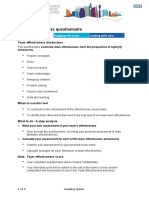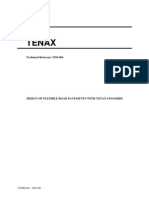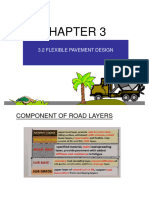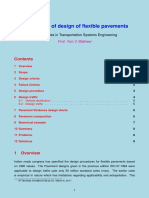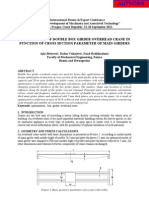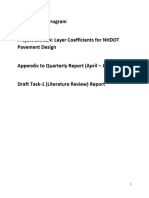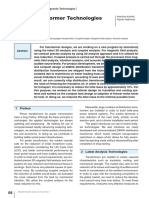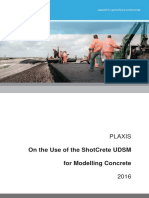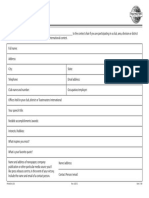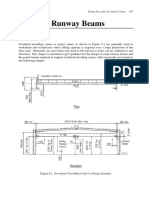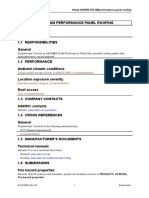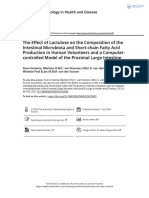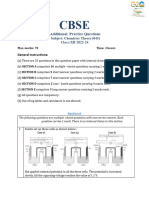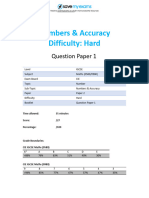TN167 - A New Approach To Asphalt Pavement Design
TN167 - A New Approach To Asphalt Pavement Design
Uploaded by
MacCopyright:
Available Formats
TN167 - A New Approach To Asphalt Pavement Design
TN167 - A New Approach To Asphalt Pavement Design
Uploaded by
MacOriginal Title
Copyright
Available Formats
Share this document
Did you find this document useful?
Is this content inappropriate?
Copyright:
Available Formats
TN167 - A New Approach To Asphalt Pavement Design
TN167 - A New Approach To Asphalt Pavement Design
Uploaded by
MacCopyright:
Available Formats
Technical Note 167
A New Approach to Asphalt Pavement Design
February 2017
Copyright
http://creativecommons.org/licenses/by/3.0/au/
© State of Queensland (Department of Transport and Main Roads) 2017
Feedback: Please send your feedback regarding this document to: tmr.techdocs@tmr.qld.gov.au
Technical Note, Transport and Main Roads, February 2017
Contents
1 Introduction ....................................................................................................................................1
2 Comparison with existing procedure ..........................................................................................1
3 Asphalt design modulus ...............................................................................................................2
3.1 Determination of design modulus from measured modulus values ................................................ 3
3.2 Design modulus from published data ............................................................................................. 4
4 Asphalt fatigue relationships .......................................................................................................5
4.1 Mix-specific fatigue relationship ...................................................................................................... 6
4.2 Presumptive fatigue relationship..................................................................................................... 7
5 Upper limit on design traffic for asphalt fatigue in full depth asphalt pavements .................7
6 Improved method for considering multiple-axle group loads ..................................................9
7 Implementation considerations for mix-specific modulus and fatigue relationships ............9
7.1 Mix registration................................................................................................................................ 9
7.2 Laboratory testing ........................................................................................................................... 9
7.3 Pavement design considerations .................................................................................................. 10
7.4 Material and construction specifications ....................................................................................... 10
8 References ................................................................................................................................... 10
Appendix A – Example construction of flexural modulus master curve ....................................... 12
Appendix B – Example determination of design modulus from flexural modulus master curve 19
Appendix C – Example development of mix-specific fatigue relationship .................................... 21
Appendix D – Improved method for considering multiple-axle group loads ................................ 23
D.1 Introduction ..................................................................................................................................... 23
D.2 Pavement design traffic for assessment of asphalt fatigue ............................................................ 23
D.3 Procedure for assessment of fatigue of asphalt ............................................................................. 23
D.4 Procedure for assessment of loss of surface shape....................................................................... 25
Appendix E – Example full depth asphalt pavement design .......................................................... 27
E.1 Introduction ..................................................................................................................................... 27
E.2 Design inputs .................................................................................................................................. 27
E.3 Calculation of design traffic for asphalt fatigue assessment ........................................................... 29
E.4 Assessment of fatigue of asphalt .................................................................................................... 31
E.5 Assessment of loss of surface shape ............................................................................................. 37
E.6 Construction tolerance .................................................................................................................... 39
E.7 Comparison of result with existing design procedures ................................................................... 39
Technical Note, Transport and Main Roads, February 2017 i
TN167 A New Approach to Asphalt Pavement Design
1 Introduction
The purpose of this technical note is to facilitate the implementation of new procedures for the design
of more cost effective asphalt pavements in Queensland. This technical note brings together the
findings from several related research projects into a practical guide for pavement designers and
asphalt contractors.
Pavement design procedures for asphalt pavements are still evolving. Hence, the procedures in this
technical note are considered interim, and are likely to be updated following greater experience with
their use, and as further research is completed. Users of this technical note are encouraged to consult
with the Pavements, Research and Innovation Section of Transport and Main Roads.
This technical note is to be read in conjunction with the Transport and Main Roads Pavement Design
Supplement.
The main features of the new procedures are:
1. Asphalt modulus is described through the use of a flexural modulus master curve
2. Asphalt fatigue life can be determined using a mix-specific fatigue relationship
3. An upper limit on design traffic for asphalt fatigue in full depth asphalt pavements
4. An improved method for considering heavy vehicle axle group loads.
2 Comparison with existing procedure
A comparison between the new procedures in this technical note and the existing procedures in the
Pavement Design Supplement and Part 2: Pavement Structural Design of the Austroads Guide to
Pavement Technology (AGPT02) (Austroads, 2012) is provided in Table 2.
Table 2 – Comparison of new procedures with existing procedures
Existing Pavement Design
Aspect New Procedure
Supplement / AGPT02
Asphalt design modulus Presumptive values from Mix-specific flexural modulus
indirect tensile test master curve, or presumptive
flexural modulus master curve
Asphalt fatigue relationship Adjusted Shell relationship Mix-specific fatigue
relationship, or presumptive
relationship
Limiting asphalt thickness Thickness unlimited Thickness capped by an upper
limit on design traffic loading
Critical strain Under standard axle Under each axle in the traffic
load distribution
Material and construction Standard specifications Standard specifications with
specifications including MRTS30 Asphalt supplementary requirements
Pavements
Each of the aspects listed in Table 2 is addressed in subsequent sections of this technical note.
Worked examples are also provided in the appendices to further illustrate use of the new design
procedures.
Technical Note, Transport and Main Roads, February 2017 1
TN167 A New Approach to Asphalt Pavement Design
3 Asphalt design modulus
The new procedure introduces the concept of the flexural modulus master curve to describe the
variation of asphalt modulus with varying temperature and load frequency. It is necessary to define a
flexural modulus master curve for each asphalt mix used in the pavement structure.
The adopted form of the flexural modulus master curve is the sigmoidal function as shown in
Equation 1.
𝛼𝛼
log10 |𝐸𝐸 ∗ | = 𝛿𝛿 + (1)
1+𝑒𝑒 𝛽𝛽+𝛾𝛾 log10 𝑓𝑓𝑟𝑟
where:
𝐸𝐸 ∗ = flexural modulus (MPa)
𝛼𝛼, 𝛽𝛽, 𝛾𝛾, 𝛿𝛿 = master curve fitting parameters
𝑓𝑓𝑟𝑟 = reduced frequency, as defined in Equation 2
𝑓𝑓𝑟𝑟 = 𝛼𝛼 𝑇𝑇 × 𝑓𝑓𝑇𝑇274 (2)
where:
𝑓𝑓𝑇𝑇274 = frequency (Hz) in flexural modulus test (AGPT/T274)
𝛼𝛼 𝑇𝑇 = temperature shift factor (°C) as defined in Equation 3
2
log10 (𝑎𝑎 𝑇𝑇 ) = 𝑎𝑎�𝑇𝑇 − 𝑇𝑇𝑟𝑟𝑟𝑟𝑟𝑟 � + 𝑏𝑏�𝑇𝑇 − 𝑇𝑇𝑟𝑟𝑟𝑟𝑟𝑟 � (3)
where:
𝑎𝑎, 𝑏𝑏 = fitting parameters
𝑇𝑇𝑟𝑟𝑟𝑟𝑟𝑟 = reference temperature (°C), typically 25°C
𝑇𝑇 = test temperature for development of the master curve; and also 𝑇𝑇 = design
temperature for determination of design modulus (°C). The design temperature is
typically the weighted mean annual pavement temperature (WMAPT).
By combining Equations 1, 2 and 3, the flexural modulus can be determined at any combination of
temperature and flexural modulus test frequency. Further to this, by defining the relationship between
heavy vehicle speed and flexural modulus test frequency (Equation 5), the design modulus can be
determined at any combination of temperature and heavy vehicle speed.
The flexural modulus master curve may either be mix-specific (from measured modulus, as detailed in
Section 3.1) or presumptive (from published data, as detailed in Section 3.2). The flexural modulus
master curve is used to determine the design modulus as detailed in the following sections.
Technical Note, Transport and Main Roads, February 2017 2
TN167 A New Approach to Asphalt Pavement Design
3.1 Determination of design modulus from measured modulus values
Determination of a mix-specific design modulus involves the measurement of flexural modulus of test
beams at a range of temperatures and load frequencies. Laboratory requirements for flexural fatigue
testing are detailed in Section 7. Section 7 also details additional controls that are to be established in
production and construction to ensure that the mix-specific design properties are consistently
achieved.
The methodology for determining the mix-specific design modulus is as follows:
a) The flexural modulus of the asphalt mix is to be characterised in accordance with AGPT/T274.
b) Testing shall be performed on laboratory mixed asphalt, prepared in accordance with
AS 2891.2.1, or plant mixed asphalt. Note that in accordance with AGPT/T220, reheating for
sample preparation is not permitted.
c) A minimum of four specimens shall be tested. The temperature sweep shall include testing at
5°C, 15°C, 25°C, 30°C and 40°C. The frequency sweep shall be performed over as wide a
range of frequencies as possible, but including at least eight frequencies between 0.1 Hz and
20 Hz (for example, 0.1, 0.5, 1, 3, 5, 10, 15, 20, 30, 1 Hz).
d) Using the flexural modulus data (averaged for each combination of test temperature and test
frequency), derive the master curve using the sigmoidal function, as detailed in AGPT/T274.
The fitting parameters in Equations 1 and 3 are determined by maximising the coefficient of
determination (R2) by correlating log10 |𝐸𝐸 ∗ | calculated from the test results with log10 |𝐸𝐸 ∗ |
estimated using Equation 1. R2 is as defined in Equation 4.
∑ (𝑦𝑦 −𝑧𝑧𝑖𝑖 )2
𝑅𝑅2 = 1 − ∑𝑖𝑖 (𝑦𝑦𝑖𝑖 �) 2
(4)
𝑖𝑖 𝑖𝑖 −𝑦𝑦
where:
𝑦𝑦𝑖𝑖 = log10 |𝐸𝐸 ∗ | values calculated from the flexural modulus test results
𝑧𝑧𝑖𝑖 = log10 |𝐸𝐸 ∗ | values estimated using Equation 1
𝑦𝑦� = average log10 |𝐸𝐸 ∗ | calculated from the flexural modulus test results
e) To determine the design modulus from the derived master curve and fitting parameters:
i. Determine the temperature shift (𝛼𝛼 𝑇𝑇 ) at the design temperature (WMAPT) using
Equation 3
ii. Determine the flexural modulus test frequency (𝑓𝑓𝑇𝑇274) equivalent to the load frequency
under a heavy vehicle travelling at the design heavy vehicle speed (𝑉𝑉) using Equation 5
𝑉𝑉
𝑓𝑓𝑇𝑇274 = (5)
2𝜋𝜋
where:
𝑉𝑉 = design heavy vehicle speed (km/h)
𝑓𝑓𝑇𝑇274 = frequency (Hz) in flexural modulus test (AGPT/T274)
Technical Note, Transport and Main Roads, February 2017 3
TN167 A New Approach to Asphalt Pavement Design
The design heavy vehicle speed in this technical note is the representative vehicle
operating speed and not the geometric design speed.
iii. Determine the reduced frequency (𝑓𝑓𝑟𝑟 ) at the design temperature and heavy vehicle speed
using Equation 2
iv. Determine the flexural modulus (E*) at the design temperature and heavy vehicle speed
using Equation 1
v. Adjust the modulus from the test air voids (typically 5.0%) to the modulus at the in-service
air voids using Equation 6. In-service air voids for mixes placed in accordance with
Transport and Main Roads specifications are typically assumed to be 7.0% for AC7 and
AC10 mixes; 6.0% for AC14, AC20 and SMA10 mixes; 5.0% for SMA14 mixes; and 4.5%
for EME2 mixes.
(21−𝑖𝑖𝑖𝑖 𝑠𝑠𝑠𝑠𝑠𝑠𝑠𝑠𝑠𝑠𝑠𝑠𝑠𝑠 𝑎𝑎𝑎𝑎𝑎𝑎 𝑣𝑣𝑣𝑣𝑣𝑣𝑣𝑣𝑣𝑣)
𝑀𝑀𝑀𝑀𝑀𝑀𝑀𝑀𝑀𝑀𝑀𝑀𝑀𝑀 𝑎𝑎𝑎𝑎 𝑖𝑖𝑖𝑖 𝑠𝑠𝑠𝑠𝑠𝑠𝑠𝑠𝑠𝑠𝑠𝑠𝑠𝑠 𝑎𝑎𝑎𝑎𝑎𝑎 𝑣𝑣𝑣𝑣𝑣𝑣𝑣𝑣𝑣𝑣 = 𝑀𝑀𝑀𝑀𝑀𝑀𝑀𝑀𝑀𝑀𝑀𝑀𝑀𝑀 𝑎𝑎𝑡𝑡 𝑡𝑡𝑡𝑡𝑡𝑡𝑡𝑡 𝑎𝑎𝑎𝑎𝑎𝑎 𝑣𝑣𝑣𝑣𝑣𝑣𝑣𝑣𝑣𝑣 × (21−𝑡𝑡𝑡𝑡𝑡𝑡𝑡𝑡 𝑎𝑎𝑎𝑎𝑎𝑎 𝑣𝑣𝑣𝑣𝑣𝑣𝑣𝑣𝑣𝑣)
(6)
f) The resulting value, typically rounded to the nearest multiple of 100 MPa, is the design
modulus (𝐸𝐸𝑑𝑑 ).
g) The design modulus (𝐸𝐸𝑑𝑑 ) is typically limited to a minimum value of 1000 MPa for dense
graded and stone mastic asphalt.
This procedure replaces the guidance provided in the Pavement Design Supplement for the
determination of design modulus from measured modulus.
A worked example illustrating the construction of a master curve from test data, and subsequent
determination of the design modulus, is provided in Appendices A and B.
For the establishment of construction compliance limits (refer to Section 7), the resilient modulus of
the asphalt material at 25°C shall be determined in accordance with AS 2891.13.1. Testing shall be
performed on laboratory mixed asphalt, prepared in accordance with AS 2891.2.1, or plant mixed
asphalt. Reheating of asphalt mix for sample preparation is not permitted. A minimum of five
specimens shall be tested, with the mean value used to establish construction compliance limits.
3.2 Design modulus from published data
Presumptive design modulus values are currently published in the Pavement Design Supplement for
standard mixes. The Pavement Design Supplement values may continue to be used.
Alternatively, the parameters detailed in Table 3.2 can be used to define presumptive flexural modulus
master curves for standard asphalt mixes. The presumptive design modulus (𝐸𝐸𝑑𝑑 ) is determined
following steps e), f) and g) in Section 3.1, but using the parameters from Table 3.2. Adjustment from
test air voids to in-service air voids is not required as this step has already been undertaken in the
development of the presumptive master curve parameters.
Technical Note, Transport and Main Roads, February 2017 4
TN167 A New Approach to Asphalt Pavement Design
Table 3.2 – Presumptive flexural modulus master curve parameters for 25ºC reference
temperature
Volume
Asphalt
Binder of Er25
Mix 𝜶𝜶 𝜷𝜷 𝜸𝜸 𝜹𝜹 𝒂𝒂 𝒃𝒃
Type Binder (MPa)
Type
(%)
SMA14 A5S 13.0 2400 15.3 0.0 -0.0958 -4.700 1.191×10-5 -0.0951
AC10M C320 11.5 3500 15.3 0.0 -0.0958 -4.536 1.191×10-5 -0.0951
AC10M
A5S 11.5 2200 15.3 0.0 -0.0958 -4.738 1.191×10-5 -0.0951
AC10H
AC14M C320 11.0 4500 15.3 0.0 -0.0958 -4.427 1.191×10-5 -0.0951
AC14M
C600 11.0 5400 15.3 0.0 -0.0958 -4.348 1.191×10-5 -0.0951
AC14H
AC14M
A5S 11.0 2800 15.3 0.0 -0.0958 -4.633 1.191×10-5 -0.0951
AC14H
AC20M C320 10.5 4800 15.3 0.0 -0.0958 -4.399 1.191×10-5 -0.0951
AC20M
C600 10.5 5800 15.3 0.0 -0.0958 -4.317 1.191×10-5 -0.0951
AC20H
EME2 15/25 13.5 7800 15.3 0.0 -0.0958 -4.188 1.191×10-5 -0.0951
The presumptive master curves in Table 3.2 were derived from the presumptive design moduli in the
Pavement Design Supplement. Therefore, it is expected that the design moduli determined using the
presumptive master curves will not change from the values in the current Pavement Design
Supplement (noting some minor rounding errors are possible). Presumptive values in the Pavement
Design Supplement were generally derived from indirect tensile test (ITT) results of Transport and
Main Roads registered mix designs. For mixes where limited or no data was available, the
presumptive values were determined based on relationships with other mixes. A presumptive design
modulus of 800 MPa is typically used for open graded asphalt for all WMAPTs and heavy vehicle
speeds. In Table 3.2, Er25 is the presumptive resilient modulus (ITT modulus) at 25°C (corrected to the
typical in-service air voids).
A worked example illustrating the determination of the design modulus from the master curve is
provided in Appendix B.
4 Asphalt fatigue relationships
The new procedure in this technical note provides for use of either a mix-specific or a presumptive
asphalt fatigue relationship. Both approaches are detailed in the following sections.
Where a mix-specific design modulus is used, a mix-specific fatigue relationship must also be used.
Likewise, where a presumptive modulus is used, the presumptive fatigue relationship must also be
used.
Technical Note, Transport and Main Roads, February 2017 5
TN167 A New Approach to Asphalt Pavement Design
4.1 Mix-specific fatigue relationship
Determination of a mix-specific fatigue relationship involves laboratory flexural fatigue testing of
asphalt beams at a range of temperatures and strain levels. Laboratory requirements for flexural
fatigue testing are detailed in Section 7. Section 7 also details additional controls that are to be
established in production and construction to ensure that the mix-specific design properties are
consistently achieved.
The methodology for determining the mix-specific fatigue relationship is as follows (NACOE, 2016a):
a) The fatigue performance of the asphalt mix is to be characterised in accordance with
AGPT/T274.
b) A minimum of 27 specimens shall be tested, comprising nine specimens at each test
temperature (10°C, 20°C and 30°C), with testing equally divided over three strain levels, using
a test frequency of 10 Hz. The strain levels shall be chosen in such a way that the fatigue lives
for all specimens exceed 104 cycles. The strain levels shall be selected so that the number of
cycles to failure exceeds 106 for at least 22% of specimens tested at each temperature.
c) Fit the model in Equation 7 to the laboratory data (without any averaging of data). This model
is known as the mix-specific laboratory fatigue relationship. Failure in the laboratory fatigue
test is defined as a 50% reduction in modulus, where the initial modulus is the modulus at the
50th load cycle.
𝑁𝑁𝑙𝑙𝑙𝑙𝑙𝑙 = 𝐸𝐸𝐸𝐸𝐸𝐸[𝑐𝑐1 ⋅ 𝑙𝑙𝑙𝑙3 (𝐸𝐸) + 𝑐𝑐2 ⋅ 𝑙𝑙𝑙𝑙2 (𝐸𝐸) + 𝑐𝑐3 ⋅ 𝑙𝑙𝑙𝑙(𝐸𝐸) + 𝑐𝑐4 + 𝑐𝑐5 ⋅ 𝑙𝑙𝑙𝑙(𝜇𝜇𝜀𝜀𝑙𝑙𝑙𝑙𝑙𝑙 )] (7)
where:
𝑁𝑁𝑙𝑙𝑙𝑙𝑙𝑙 = number of cycles to failure in the laboratory flexural fatigue test
𝐸𝐸= flexural modulus (MPa) at the test frequency and test temperature, determined
from the master curve (Equation 1)
𝜇𝜇𝜀𝜀𝑙𝑙𝑙𝑙𝑙𝑙 = strain in laboratory flexural fatigue test (µm/m)
𝑐𝑐1 − 𝑐𝑐5 = fitting parameters
The fitting parameters in Equation 7 are determined by maximising the coefficient of
determination (R2) by correlating ln(𝑁𝑁𝑙𝑙𝑙𝑙𝑙𝑙 ) calculated from the test results with ln(𝑁𝑁𝑙𝑙𝑙𝑙𝑙𝑙 )
estimated using Equation 7. R2 is as defined in Equation 4, except:
𝑦𝑦𝑖𝑖 = ln(𝑁𝑁𝑙𝑙𝑙𝑙𝑙𝑙 ) values calculated from the flexural fatigue test results
𝑧𝑧𝑖𝑖 = ln(𝑁𝑁𝑙𝑙𝑙𝑙𝑙𝑙 ) values estimated using Equation 7
𝑦𝑦� = average ln(𝑁𝑁𝑙𝑙𝑙𝑙𝑙𝑙 ) calculated from the flexural fatigue test results
d) The mix-specific fatigue relationship used in pavement design is then determined from
Equation 8.
𝑁𝑁 = 𝑅𝑅𝑅𝑅 × 𝐸𝐸𝐸𝐸𝐸𝐸[𝑐𝑐1 ⋅ 𝑙𝑙𝑙𝑙3 (𝐸𝐸𝑑𝑑 ) + 𝑐𝑐2 ⋅ 𝑙𝑙𝑙𝑙2 (𝐸𝐸𝑑𝑑 ) + 𝑐𝑐3 ⋅ 𝑙𝑙𝑙𝑙(𝐸𝐸𝑑𝑑 ) + 𝑐𝑐4 + 𝑐𝑐5 ⋅ 𝑙𝑙𝑙𝑙(𝜇𝜇𝜇𝜇)] (8)
Technical Note, Transport and Main Roads, February 2017 6
TN167 A New Approach to Asphalt Pavement Design
where:
𝑁𝑁 = allowable number of repetitions of the load
𝐸𝐸𝑑𝑑 = design flexural modulus as determined in Section 3 (MPa)
𝜇𝜇𝜇𝜇 = tensile strain produced by the load, determined by mechanistic design (µm/m)
𝑐𝑐1 − 𝑐𝑐5 = regression coefficients (fitting parameters) determined from Equation 7
𝑅𝑅𝑅𝑅 = reliability factor for asphalt fatigue, as per AGPT02
e) To mitigate some of the risk and uncertainty involved in implementing this new pavement
design procedure, and without being unduly restrictive in its implementation, the mix-specific
fatigue relationship used in pavement design is to be limited as follows:
i. For pavements with multiple asphalt layers: the reduction in asphalt thickness obtained
using the mix-specific modulus and mix-specific fatigue relationship is not to exceed 10%
of the thickness determined using the presumptive design modulus and adjusted Shell
relationship (Equation 11) in AGPT02 (including the presumptive binder volume).
ii. For asphalt surfaced granular pavements: the predicted fatigue life of the asphalt using
the mix-specific modulus and mix-specific fatigue relationship is to be no more than three
times the fatigue life predicted using the presumptive design modulus and adjusted Shell
relationship (Equation 11) in AGPT02 (including the presumptive binder volume).
These comparisons are to be made prior to the addition of any construction tolerances. These
limits are additional to any reduction in thickness, or increase in fatigue life, resulting from the
improved method for considering multiple-axle group loads detailed in Section 6. It is
anticipated that these limits will be reviewed in the future when more information on the fatigue
performance of Queensland mixes is available.
A worked example illustrating the development of a mix-specific fatigue relationship is provided in
Appendix C.
4.2 Presumptive fatigue relationship
The presumptive asphalt fatigue relationship is the adjusted Shell relationship included in AGPT02,
except Smix (asphalt resilient modulus) is replaced with the presumptive design flexural modulus (Ed),
calculated using the parameters in Table 3.2.
Where the mix-specific modulus is used in pavement design, the presumptive asphalt fatigue
relationship cannot be used. The mix specific modulus can only be used in combination with the mix-
specific fatigue relationship determined in accordance with Section 4.1.
As further mix-specific fatigue testing is undertaken, it may be possible to develop presumptive fatigue
relationships for various mix types incorporating specific binder classes.
5 Upper limit on design traffic for asphalt fatigue in full depth asphalt pavements
AGPT02 notes that there is increasing recognition of the notion that asphalt mixes have endurance
strain limits for asphalt fatigue. This suggests that below a given applied strain, repeated cycles of
loading no longer result in fatigue damage. Development of an Austroads-endorsed procedure to
incorporate the fatigue endurance limit concept into AGPT02 is ongoing, with assessment of the latest
relevant international research underway. This includes consideration of the draft outcomes from the
Technical Note, Transport and Main Roads, February 2017 7
TN167 A New Approach to Asphalt Pavement Design
Australian Asphalt Pavement Association's Asphalt Pavement Solutions for Life project (Sullivan et al,
2015).
Until such time that an Austroads-endorsed procedure is published, as an interim approach for full
depth asphalt pavements, a maximum (capped) asphalt thickness corresponding to a design traffic
loading of 200 million equivalent standard axles (ESA) has been adopted by Transport and Main
Roads for locations with a weighted mean annual pavement temperature (WMAPT) of 30°C or greater
(NACOE, 2016b). This limit is relevant when the traffic loads are considered in accordance with
Section 6.
Adoption of the upper limit on design traffic for asphalt fatigue in full depth asphalt pavements requires
inclusion of the following minimum support conditions:
• An improved layer below the asphalt base course comprising a minimum 150 mm thick layer
of Type 2.3 unbound granular material that is treated with a cementitious stabilising agent to
achieve an unconfined compressive strength of 1.0 to 2.0 MPa at seven days (refer to
PSTS103 Lightly Stabilised Improved Layer)
• An additional thickness of select fill or unbound granular material (if required), based on the
bearing capacity of the underlying subgrade material, to increase the pavement support to an
adequate level for long term pavement performance. Adequate support can be determined by
using Equations 19 and 21 in AGPT02, ensuring that the modulus achieved at the top of the
improved layer is not less than 150 MPa.
For example, where the design CBR of the existing in situ subgrade material is 3%, application of
Equations 19 and 21 in AGPT02 indicates a select fill layer with minimum CBR 7% and thickness of
170 mm below a 150 mm thick lightly stabilised improved layer is necessary to achieve a modulus of
150 MPa at the top of the improved layer. Equation 19 results in a vertical modulus of 66 MPa for the
top sublayer of select fill. Equation 21 then results in a vertical modulus for the top sublayer of the
lightly stabilised improved layer of 151 MPa.
Where the design CBR of the existing in situ subgrade material is 7% or more, a 150 mm thick lightly
bound improved layer is typically adequate without the need for any additional underlying selected
material, unless required to address other issues such as expansive subgrade materials or excess
moisture.
Foamed bitumen stabilised materials can be considered as an alternative to lightly bound materials.
Where foamed bitumen stabilised materials are being considered, advice should be obtained from the
Director (Pavement Rehabilitation) on the appropriate design methodology.
While this approach provides for a minimum amount of pavement support, more substantial
treatments (to improve support conditions) are likely to have benefits in terms of overall asphalt
thickness reduction. Therefore, more substantial treatments should also be considered by the
pavement designer in assessing project-specific alternatives.
To achieve adequate compaction of the asphalt layers, additional support may be necessary
depending on the bearing capacity of lower layers at the time of construction. As a minimum, proof
rolling of the lightly bound improved layer and all other earthworks layers should be undertaken to
confirm acceptable support has been achieved prior to the construction of overlying layers.
Technical Note, Transport and Main Roads, February 2017 8
TN167 A New Approach to Asphalt Pavement Design
6 Improved method for considering multiple-axle group loads
This technical note adopts an improved method for considering multiple-axle group loads, developed
as part of Austroads project TT1614 (Austroads, 2015) and further documented by Moffatt (2015).
Currently in AGPT02, axle group loads are converted to Standard Axle Repetitions (SARs) by the use
of standard loads. Asphalt fatigue is then assessed on the basis of critical strains under a Standard
Axle.
More recent Austroads research (Austroads Project TT1614) has developed an improved method that
uses critical strains under each axle in the traffic load distribution, without any conversion to SARs.
Estimated asphalt fatigue damage is then determined as the sum of damage from each and every axle
in the traffic load distribution.
While the improved Austroads methodology may be applied to assess fatigue of both asphalt and
cemented materials, for the purposes of implementation in this technical note it is only intended to be
used for the assessment of asphalt fatigue. For fatigue of cemented materials, adoption of the
improved method must be done in conjunction with other changes to the cemented materials
pavement design procedure arising from Austroads project TT1664 (Austroads, 2014a and 2014b).
These changes are not covered in this technical note, but will be adopted by Transport and Main
Roads when the full method is published in AGPT02.
The new procedure for assessment of asphalt fatigue is detailed in Appendix D, and is also illustrated
in the design example in Appendix E.
7 Implementation considerations for mix-specific modulus and fatigue relationships
Determination of the mix-specific flexural modulus master curve and the mix-specific fatigue
relationship for an asphalt mix is optional and usually at the discretion of the Principal Asphalt
Contractor (PAC). Where these are to be determined, the requirements in Sections 7.1 to 7.4 apply.
7.1 Mix registration
The mix-specific flexural modulus master curve and the mix-specific fatigue relationship require
registration through the Transport and Main Roads asphalt mix design registration system. As well as
meeting the requirements of TN148 Asphalt Mix Design Registration (Transport and Main
Roads, 2016b), the PAC must include the following details in their asphalt mix design submission:
a) all test results and calculations to determine the mix-specific flexural modulus master curve
b) all test results and calculations to determine the mix-specific fatigue relationship
c) resilient modulus test results for the establishment of construction compliance limits
d) mix design certificate which includes the mix-specific master curve parameters and mix-
specific fatigue relationship parameters.
Asphalt mixes with mix-specific parameters will be identified in the asphalt mix design register
published on the Transport and Main Roads website. However, mix-specific parameters will not be
included in the register due to their commercial-in-confidence nature.
7.2 Laboratory testing
Laboratory testing, including sample preparation, to determine the mix-specific flexural modulus
master curve and the mix-specific fatigue relationship must be undertaken by one of the following:
Technical Note, Transport and Main Roads, February 2017 9
TN167 A New Approach to Asphalt Pavement Design
a) Transport and Main Roads laboratory
b) ARRB Group laboratory
c) An independent laboratory with NATA certification for the tests undertaken.
7.3 Pavement design considerations
It is anticipated that presumptive moduli and the presumptive fatigue relationship will continue to be
used for pavement designs where the specific mixes to be used are unknown (such as for preliminary
designs and designs for construct-only-style contracts).
Mix-specific moduli and fatigue relationships should only be adopted in pavement designs where the
specific mixes to be used are known at the time the pavement designs are undertaken, and the mix-
specific parameters for the mixes have been registered by Transport and Main Roads. This is most
likely to be possible in design and construct-style contracts.
For construct-only-style contracts, Contractors are encouraged to submit alternative tenders using
mix-specific parameters for registered mixes, unless otherwise prohibited in the project-specific
requirements.
7.4 Material and construction specifications
The new pavement design procedure presented in Sections 3.1 and 4.1 is based on the use of a mix-
specific modulus and mix-specific fatigue relationship. This requires additional controls to be
established in the production and placement of the asphalt to ensure design assumptions are
consistently met. The following supplementary provisions must be specified in the contract documents
when pavement designs have been determined using mix-specific parameters:
• Minimum and maximum limits on the average resilient modulus at 25°C must be specified.
The limits are established using an allowable tolerance of ± 20% from the average resilient
modulus at 25°C measured on the material used for the development of the mix-specific
master curve and fatigue relationship.
• The resilient modulus of each mix shall be assessed for compliance on the first lot
incorporated into the Works, and subsequently on every 5000 tonnes thereafter. If a non-
compliance occurs then the next lot after the non-compliance shall also be tested, and
subsequently on every 5000 tonnes thereafter.
• For the assessment of compliance, the resilient modulus of the asphalt material at 25°C shall
be determined in accordance with AS 2891.13.1. Testing shall be performed on laboratory
mixed asphalt, prepared in accordance with AS 2891.2.1, or plant mixed asphalt. Reheating
for sample preparation is not permitted. The mean value of the resilient modulus shall be
determined from tests on a set of five specimens (with samples spread evenly during
production).
8 References
Australian Standards (2013), Methods of sampling and testing asphalt - Determination of the resilient
modulus of asphalt - Indirect tensile method, AS 2891.13.1, Australian Standards.
Australian Standards (2014), Methods of sampling and testing asphalt - Sample preparation - Mixing,
quartering and conditioning of asphalt in the laboratory, AS 2891.2.1, Australian Standards.
Technical Note, Transport and Main Roads, February 2017 10
TN167 A New Approach to Asphalt Pavement Design
Austroads (2005), Sample preparation - compaction of asphalt slabs, AGPT/T220, Austroads, Sydney,
NSW.
Austroads (2012), Guide to Pavement Technology, Part 2: Pavement Structural Design, AGPT02,
Austroads, Sydney, NSW.
Austroads (2014a), Cemented materials characterisation: final report, AP-R462-14, Austroads,
Sydney, NSW.
Austroads (2014b), Framework for the revision of Austroads design procedures for pavements
containing cemented materials, AP-R463-14, Austroads, Sydney, NSW.
Austroads (2015), The influence of multiple-axle group loads on flexible pavement design, AP-R486-
15, Austroads, Sydney, NSW.
Moffatt, M. (2015), Improved consideration of multiple-axle group loads: proposed revisions to flexible
pavement structural design procedures, Austroads draft internal working paper, ARRB Group,
Melbourne, Victoria.
Austroads (2016), Characterisation of flexural stiffness and fatigue performance of bituminous mixes,
AGPT/T274, Austroads, Sydney, NSW.
NACOE (2016a), Improved characterisation of fatigue in asphalt at Queensland temperatures,
National Asset Centre of Excellence, Brisbane, Queensland.
NACOE (2016b), Long-life pavement for Queensland (Year 2), National Asset Centre of Excellence,
Brisbane, Queensland.
Sullivan B, Youdale G, Rickards I & Yousefdoost S (2015), Technical background to the development
of the AAPA long life asphalt pavement design procedure, draft October, Australian Asphalt Pavement
Association, Melbourne, Australia.
Transport and Main Roads (2013), Pavement Design Supplement, Transport and Main Roads,
Brisbane, Queensland.
Transport and Main Roads (2015), PSTS103 Lightly Stabilised Improved Layer, Transport and Main
Roads Project Specific Technical Specification, October 2015, Transport and Main Roads, Brisbane,
Queensland.
Transport and Main Roads (2016a), MRTS30 Asphalt Pavements, Transport and Main Roads
Specifications, January 2016, Transport and Main Roads, Brisbane, Queensland.
Transport and Main Roads (2016b), TN148 Asphalt Mix Design Registration, Transport and Main
Roads, Brisbane, Queensland.
Technical Note, Transport and Main Roads, February 2017 11
TN167 A New Approach to Asphalt Pavement Design
Appendix A – Example construction of flexural modulus master curve
This appendix illustrates the construction of a flexural modulus master curve from flexural modulus
test data for an AC20M(C600) asphalt mix. The master curve is determined for a reference
temperature (Tref) of 25°C at the test air voids content of 5.0%.
In this example, flexural modulus testing (AGPT/T274) has been undertaken on five laboratory mixed
and compacted asphalt specimens. Each specimen has been tested at temperatures of 5, 15, 25,
30°C and 40°C, and at frequencies of 0.1, 0.5, 1, 3, 5, 10, 15, and 20 Hz.
The test results are presented in Table A.1, together with the average result and the logarithm of the
average result, at each combination of test temperature and test frequency.
It is noted that the test data in the appendices of this technical note has been artificially produced to
illustrate the calculation methodologies.
Technical Note, Transport and Main Roads, February 2017 12
TN167 A New Approach to Asphalt Pavement Design
Table A.1 – Flexural modulus test results
Flexural Modulus Test Results (MPa)
Test
Test Average
Temp.
Freq. (f) flexural
(T)
(Hz) Specimen Specimen Specimen Specimen Specimen modulus
(oC)
A B C D E (E*) (MPa) 𝐥𝐥𝐥𝐥𝐥𝐥 𝟏𝟏𝟏𝟏 |𝑬𝑬∗ |
5 0.1 11,519 11,899 9,183 8,779 10,354 10,347 4.01
5 0.5 13,751 15,453 11,956 11,395 13,439 13,199 4.12
5 1 14,880 16,639 13,135 12,495 14,581 14,346 4.16
5 3 16,658 18,876 14,983 14,114 16,510 16,228 4.21
5 5 17,429 19,967 15,924 15,027 17,511 17,172 4.23
5 10 18,354 19,117 16,999 16,013 17,579 17,612 4.25
5 15 18,659 19,211 17,724 16,541 17,890 18,005 4.26
5 20 18,723 20,032 18,070 16,771 18,416 18,402 4.26
15 0.1 4,398 4,103 3,998 3,591 3,862 3990 3.60
15 0.5 6,850 6,653 6,308 5,900 6,290 6400 3.81
15 1 7,916 7,660 7,310 6,860 7,274 7404 3.87
15 3 10,159 9,544 9,340 8,761 9,167 9394 3.97
15 5 11,237 10,621 10,285 9,661 10,155 10,392 4.02
15 10 12,595 11,878 11,595 10,821 11,363 11,650 4.07
15 15 13,539 12,518 12,118 11,493 12,020 12,338 4.09
15 20 13,736 12,846 12,571 11,759 12,317 12,646 4.10
25 0.1 922 962 956 895 943 936 2.97
25 0.5 1,962 1,955 1,959 1,820 1,902 1,920 3.28
25 1 2,682 2,657 2,484 2,449 2,567 2,568 3.41
25 3 4,103 4,280 4,026 3,723 4,015 4,029 3.61
25 5 4,854 4,989 4,742 4,394 4,706 4,737 3.68
25 10 6,090 6,180 5,855 5,458 5,833 5,883 3.77
25 15 6,718 6,901 6,521 5,959 6,444 6,509 3.81
25 20 7,184 7,105 6,780 6,306 6,719 6,819 3.83
30 0.1 647 668 657 647 672 658 2.82
30 0.5 1,268 1,255 1,223 1,176 1,230 1,230 3.09
30 1 1,708 1,675 1,562 1,563 1,633 1,628 3.21
30 3 2,680 2,758 2,588 2,447 2,617 2,618 3.42
30 5 3,257 3,329 3,108 2,955 3,155 3,161 3.50
30 10 4,167 4,216 3,940 3,778 4,010 4,022 3.60
30 15 4,760 4,731 4,410 4,173 4,466 4,508 3.65
30 20 5,113 4,938 4,643 4,452 4,709 4,771 3.68
40 0.1 318 340 275 373 326 326 2.51
40 0.5 600 465 482 684 557 558 2.75
40 1 786 656 686 825 738 738 2.87
40 3 1,247 1,054 1,088 1,394 1,195 1,196 3.08
40 5 1,651 1,342 1,405 1,829 1,557 1,557 3.19
40 10 2,284 1,958 2,021 2,646 2,227 2,227 3.35
40 15 2,740 2,268 2,446 3,088 2,636 2,636 3.42
40 20 2,961 2,524 2,634 3,438 2,890 2,889 3.46
Technical Note, Transport and Main Roads, February 2017 13
TN167 A New Approach to Asphalt Pavement Design
The next step is to calculate the temperature shift factor using Equation 3, the reduced frequency
using Equation 2, and the predicated log10 |𝐸𝐸 ∗ | using Equation 1. In these calculations, the seed values
for the master curve parameters from AGPT/T274, as reproduced in Table A.2, were initially used.
Results are shown in Table A.3, alongside the actual log10 |𝐸𝐸 ∗ | from the test results (as per Table A.1).
The last two columns in Table A.3 show the calculation of the sum of squared residuals and the sum
of squared deviations from the mean, which are used in Equation 4 to calculate R².
Table A.2 – Seed values for master curve fitting parameters
Parameter 𝛼𝛼 𝛽𝛽 𝛾𝛾 𝛿𝛿 𝑎𝑎 𝑏𝑏
Seed Value 1.6 -1.0 -0.73 2.7 0.0003 -0.1
Technical Note, Transport and Main Roads, February 2017 14
TN167 A New Approach to Asphalt Pavement Design
Table A.3 – Predicted 𝒍𝒍𝒍𝒍𝒍𝒍𝟏𝟏𝟏𝟏 |𝑬𝑬∗ | using seed values for master curve fitting parameters
(Tref = 25ºC)
Test Test Reduced
Temp. Freq. Test Result Temperature Frequency Predicted
(T) (f) 𝐥𝐥𝐥𝐥𝐥𝐥 𝟏𝟏𝟏𝟏 |𝑬𝑬∗ | shift (𝒂𝒂𝑻𝑻 ) (fr) (Hz) 𝐥𝐥𝐥𝐥𝐥𝐥 𝟏𝟏𝟏𝟏 |𝑬𝑬∗ | (𝒚𝒚𝒊𝒊 − 𝒛𝒛𝒊𝒊 )𝟐𝟐 �)𝟐𝟐
(𝒚𝒚𝒊𝒊 − 𝒚𝒚
(oC) (Hz) (Table A.1) (Eq. 3) (Eq. 2) (Eq. 1) (Eq. 4) (Eq. 4)
5 0.1 4.01 131.83 13.18 4.08 0.00 0.15
5 0.5 4.12 131.83 65.91 4.16 0.00 0.25
5 1 4.16 131.83 131.83 4.18 0.00 0.28
5 3 4.21 131.83 395.48 4.22 0.00 0.34
5 5 4.23 131.83 659.13 4.23 0.00 0.37
5 10 4.25 131.83 1318.26 4.24 0.00 0.39
5 15 4.26 131.83 1977.39 4.25 0.00 0.40
5 20 4.26 131.83 2636.51 4.25 0.00 0.41
15 0.1 3.60 10.72 1.07 3.88 0.08 0.00
15 0.5 3.81 10.72 5.36 4.02 0.04 0.03
15 1 3.87 10.72 10.72 4.06 0.04 0.06
15 3 3.97 10.72 32.15 4.13 0.02 0.12
15 5 4.02 10.72 53.58 4.15 0.02 0.15
15 10 4.07 10.72 107.15 4.18 0.01 0.19
15 15 4.09 10.72 160.73 4.19 0.01 0.22
15 20 4.10 10.72 214.30 4.20 0.01 0.23
25 0.1 2.97 1.00 0.10 3.61 0.40 0.43
25 0.5 3.28 1.00 0.50 3.80 0.26 0.12
25 1 3.41 1.00 1.00 3.87 0.21 0.05
25 3 3.61 1.00 3.00 3.97 0.13 0.00
25 5 3.68 1.00 5.00 4.01 0.11 0.00
25 10 3.77 1.00 10.00 4.06 0.08 0.02
25 15 3.81 1.00 15.00 4.08 0.07 0.04
25 20 3.83 1.00 20.00 4.10 0.07 0.04
30 0.1 2.82 0.32 0.03 3.46 0.42 0.65
30 0.5 3.09 0.32 0.16 3.67 0.33 0.29
30 1 3.21 0.32 0.32 3.75 0.29 0.17
30 3 3.42 0.32 0.97 3.87 0.20 0.04
30 5 3.50 0.32 1.61 3.92 0.17 0.02
30 10 3.60 0.32 3.22 3.98 0.14 0.00
30 15 3.65 0.32 4.83 4.01 0.13 0.00
30 20 3.68 0.32 6.43 4.03 0.12 0.00
40 0.1 2.51 0.04 0.00 3.20 0.48 1.23
40 0.5 2.75 0.04 0.02 3.39 0.42 0.77
40 1 2.87 0.04 0.04 3.48 0.38 0.57
40 3 3.08 0.04 0.11 3.62 0.29 0.30
40 5 3.19 0.04 0.18 3.68 0.24 0.19
40 10 3.35 0.04 0.37 3.76 0.17 0.08
40 15 3.42 0.04 0.55 3.81 0.15 0.04
40 20 3.46 0.04 0.74 3.84 0.14 0.03
3.62 5.66
- - (average) - - - (sum) 8.67 (sum)
Technical Note, Transport and Main Roads, February 2017 15
TN167 A New Approach to Asphalt Pavement Design
Using Equation 4, R² is calculated as 1 – 5.66/8.67 = 0.347.
The next step is to maximise R² by iterating the master curve fitting parameters. This was done by
using the Solver function in Microsoft Excel to change the variable cells containing the seed values for
the master curve fitting parameters. The “GRG Nonlinear” solving method using central derivatives
and without automatic scaling was used as shown in Figure A.1.
Figure A.1 – Microsoft Excel Solver parameters and options
Tables A.2 and A.3 are then replaced by the results as shown in Tables A.4 and A.5.
Table A.4 – Mix-specific flexural modulus final master curve fitting parameters (Tref = 25°C)
Parameter 𝛼𝛼 𝛽𝛽 𝛾𝛾 𝛿𝛿 𝑎𝑎 𝑏𝑏
Final Value 2.579 -0.6292 -0.6704 1.742 2.156x10-3 -0.1157
Technical Note, Transport and Main Roads, February 2017 16
TN167 A New Approach to Asphalt Pavement Design
Table A.5 – Predicated 𝒍𝒍𝒍𝒍𝒍𝒍𝟏𝟏𝟏𝟏 |𝑬𝑬∗ | final master curve fitting parameters (Tref =25ºC)
Test Test Result Temperature Reduced Predicted
Temp. (T) Test Freq. 𝐥𝐥𝐥𝐥𝐥𝐥 𝟏𝟏𝟏𝟏 |𝑬𝑬∗ | shift (𝒂𝒂𝑻𝑻 ) frequency (fr) (Hz) 𝐥𝐥𝐥𝐥𝐥𝐥 𝟏𝟏𝟏𝟏 |𝑬𝑬∗ | (𝒚𝒚𝒊𝒊 − 𝒛𝒛𝒊𝒊 )𝟐𝟐 �)𝟐𝟐
(𝒚𝒚𝒊𝒊 − 𝒚𝒚
(oC) (f) (Hz) (Table A.1) (Eq. 3) (Eq. 2) (Eq. 1) (Eq. 4) (Eq. 4)
5 0.1 4.01 1502.23 150.22 4.04 0.000 0.15
5 0.5 4.12 1502.23 751.12 4.13 0.000 0.25
5 1 4.16 1502.23 1502.23 4.17 0.000 0.28
5 3 4.21 1502.23 4506.70 4.21 0.000 0.34
5 5 4.23 1502.23 7511.17 4.22 0.000 0.37
5 10 4.25 1502.23 15022.34 4.24 0.000 0.39
5 15 4.26 1502.23 22533.52 4.25 0.000 0.40
5 20 4.26 1502.23 30044.69 4.25 0.000 0.41
15 0.1 3.60 23.59 2.36 3.56 0.001 0.00
15 0.5 3.81 23.59 11.80 3.79 0.000 0.03
15 1 3.87 23.59 23.59 3.87 0.000 0.06
15 3 3.97 23.59 70.78 3.98 0.000 0.12
15 5 4.02 23.59 117.96 4.02 0.000 0.15
15 10 4.07 23.59 235.92 4.07 0.000 0.19
15 15 4.09 23.59 353.88 4.09 0.000 0.22
15 20 4.10 23.59 471.84 4.11 0.000 0.23
25 0.1 2.97 1.00 0.10 3.00 0.001 0.43
25 0.5 3.28 1.00 0.50 3.30 0.000 0.12
25 1 3.41 1.00 1.00 3.42 0.000 0.05
25 3 3.61 1.00 3.00 3.60 0.000 0.00
25 5 3.68 1.00 5.00 3.68 0.000 0.00
25 10 3.77 1.00 10.00 3.77 0.000 0.02
25 15 3.81 1.00 15.00 3.82 0.000 0.04
25 20 3.83 1.00 20.00 3.85 0.000 0.04
30 0.1 2.82 0.30 0.03 2.78 0.001 0.65
30 0.5 3.09 0.30 0.15 3.08 0.000 0.29
30 1 3.21 0.30 0.30 3.21 0.000 0.17
30 3 3.42 0.30 0.90 3.41 0.000 0.04
30 5 3.50 0.30 1.49 3.49 0.000 0.02
30 10 3.60 0.30 2.99 3.60 0.000 0.00
30 15 3.65 0.30 4.48 3.66 0.000 0.00
30 20 3.68 0.30 5.98 3.70 0.000 0.00
40 0.1 2.51 0.06 0.01 2.50 0.000 1.23
40 0.5 2.75 0.06 0.03 2.77 0.001 0.77
40 1 2.87 0.06 0.06 2.90 0.001 0.57
40 3 3.08 0.06 0.17 3.10 0.001 0.30
40 5 3.19 0.06 0.28 3.20 0.000 0.19
40 10 3.35 0.06 0.56 3.32 0.001 0.08
40 15 3.42 0.06 0.84 3.39 0.001 0.04
40 20 3.46 0.06 1.12 3.44 0.000 0.03
3.62 0.011 8.67
- - - - -
(average) (sum) (sum)
Using Equation 4, R² for the final iteration is calculated as 1-0.011/8.67 = 0.999.
Technical Note, Transport and Main Roads, February 2017 17
TN167 A New Approach to Asphalt Pavement Design
The master curve is defined by the parameters in Table A.4, in conjunction with Equation 1. These
were used to draw the master curve for the AC20M(C600) mix, as shown in Figure A.2. Figure A.2
also shows the average flexural modulus test results at the five test temperatures, and the test data
shifted to the reduced frequency (with Tref = 25°C). Hence, Figure A.2 graphically illustrates the
temperature shift (Equation 3) of the test data, and the fitting of the master curve (Equation 1) to the
shifted data.
Figure A.2 - Mix-specific flexural modulus master curve for example AC20M(C600) at Tref = 25°C
Technical Note, Transport and Main Roads, February 2017 18
TN167 A New Approach to Asphalt Pavement Design
Appendix B – Example determination of design modulus from flexural modulus
master curve
This appendix demonstrates the procedure for determining the design modulus from a flexural
modulus master curve. The flexural modulus master curve constructed in Appendix A is used in this
example. Table B.1 shows the design inputs for in-service air voids, temperature and heavy vehicle
speed. The aim is to calculate the design modulus for an asphalt layer compacted to an in-service air
voids content of 6.0%, for a design situation where the WMAPT is 32°C and the design heavy vehicle
speed is 80 km/h. Calculations are shown in Table B.1.
Table B.1 – Determination of design modulus
Step Parameter Reference Value
Mix-specific α = 2.579
flexural β = -0.6292
modulus
γ = -0.6704
master curve Master curve coefficients Table A.4
δ = 1.742
a = 2.156x10-3
b = -0.1157
Master curve reference temperature (°C) Table A.4 25
Master curve reference air voids (%) Appendix A 5.0
Design inputs Design (in-service) air voids Section 3.1 6.0
Design temperature (WMAPT) (ºC) - 32
Design heavy vehicle speed (km/h) - 80
Temperature shift (𝑎𝑎 𝑇𝑇 ) at design Equation 3 0.198
temperature (ºC)
Frequency at design heavy vehicle speed
Equation 5 12.7
(Hz)
Reduced frequency (fr) at design
temperature and design heavy vehicle Equation 2 2.515
Calculations speed (Hz)
Flexural modulus (E*) at design
temperature and design heavy vehicle Equation 1 3749
speed (MPa)
Flexural modulus (E*) at design air voids,
design temperature and design heavy Equation 6 3515
vehicle speed (MPa)
Rounded to
Result Design modulus (Ed) (MPa) nearest 3500
100 MPa
For this example, the result shown in Table B.1 would be used in the pavement design calculations.
Further to the above example, by repeating the calculations in Table B.1, the mix-specific design
modulus for the AC20M(C600) mix was also determined for other combinations of heavy vehicle
speed and temperature. Results are shown in Figure B1.
Technical Note, Transport and Main Roads, February 2017 19
TN167 A New Approach to Asphalt Pavement Design
Figure B.1 – Design modulus for various combinations of heavy vehicle speed and temperature
Technical Note, Transport and Main Roads, February 2017 20
TN167 A New Approach to Asphalt Pavement Design
Appendix C – Example development of mix-specific fatigue relationship
This appendix illustrates the development of a mix-specific flexural fatigue relationship from flexural
fatigue test data for the same example AC20M(C600) asphalt mix considered in Appendices A and B.
In this example, flexural fatigue testing (AGPT/T274) has been undertaken on 27 laboratory mixed and
compacted asphalt specimens. The specimens were equally divided among three test temperatures
(10°C, 20°C and 30°C) and three strain levels, and using a test frequency of 10 Hz for all tests. For
each test, the laboratory number of cycles to failure (defined as when the modulus reduces to 50% of
the modulus at the 50th load cycle) (Nlab) was an output of the test.
The test results are presented in Table C.1, together with the natural logarithm of Nlab.
A regression analysis was then undertaken. The fitting parameters in Equation 7 were determined by
maximising the coefficient of determination (R²) by correlating ln(𝑁𝑁𝑙𝑙𝑙𝑙𝑙𝑙 ) calculated from the test results
with ln(𝑁𝑁𝑙𝑙𝑙𝑙𝑙𝑙 ) estimated using Equation 7. Seed values used for c1 to c5 were: 0.5, -10, 80, -150 and -6
respectively. The calculation process using the Solver function in Microsoft Excel was similar to that
used in Appendix A for determining the master curve parameters (refer to Figure A.1).
In the calculation of the predicted ln(𝑁𝑁𝑙𝑙𝑙𝑙𝑙𝑙 ), the moduli used in Equation 7 were determined using
Equation 1, the master curve parameters from Table A.4 and the test frequency (10 Hz). The
calculated moduli at the three test temperatures of 10°C, 20°C and 30°C were 14,827 MPa,
8,513 MPa and 3,983 MPa respectively.
Table C.1 also shows the predicted ln(𝑁𝑁𝑙𝑙𝑙𝑙𝑙𝑙 ), and the calculation of the sum of squared residuals and
the sum of squared deviations from the mean, which were used in Equation 4 to calculate R². The
values shown are the resulting values after solving to maximise R².
Technical Note, Transport and Main Roads, February 2017 21
TN167 A New Approach to Asphalt Pavement Design
Table C.1 – Flexural fatigue test results and predicted cycles to failure
Test Test strain Lab number Predicted
Temp. amplitude of cycles to Actual 𝐥𝐥𝐥𝐥(𝑵𝑵𝒍𝒍𝒍𝒍𝒍𝒍 ) (𝒚𝒚𝒊𝒊 − 𝒛𝒛𝒊𝒊 )𝟐𝟐 �)𝟐𝟐
(𝒚𝒚𝒊𝒊 − 𝒚𝒚
Specimen (T) (oC) (µεlab) failure (𝑵𝑵𝒍𝒍𝒍𝒍𝒍𝒍 ) 𝐥𝐥𝐥𝐥(𝑵𝑵𝒍𝒍𝒍𝒍𝒍𝒍 ) (Eq. 7) (Eq. 4) (Eq. 4)
1 10 130 1,127,940 13.9 14.1 0.039 2.72
2 10 130 2,199,483 14.6 14.1 0.222 5.37
3 10 130 1,240,735 14.0 14.1 0.010 3.05
4 10 180 281,429 12.5 12.5 0.002 0.07
5 10 180 201,021 12.2 12.5 0.083 0.01
6 10 180 408,072 12.9 12.5 0.177 0.40
7 10 280 57,992 11.0 10.3 0.473 1.74
8 10 280 19,330 9.9 10.3 0.169 5.84
9 10 280 15,465 9.6 10.3 0.402 6.96
10 20 170 504,219 13.1 13.6 0.202 0.71
11 20 170 1,232,537 14.0 13.6 0.197 3.02
12 20 170 784,342 13.6 13.6 0.000 1.66
13 20 200 236,754 12.4 12.8 0.152 0.01
14 20 200 184,668 12.1 12.8 0.407 0.03
15 20 200 497,184 13.1 12.8 0.124 0.69
16 20 300 27,607 10.2 10.7 0.253 4.24
17 20 300 138,034 11.8 10.7 1.225 0.20
18 20 300 49,692 10.8 10.7 0.007 2.17
19 30 200 1,945,031 14.5 14.6 0.021 4.82
20 30 200 1,264,271 14.1 14.6 0.332 3.11
21 30 200 4,862,575 15.4 14.6 0.594 9.68
22 30 380 64,794 11.1 11.4 0.105 1.46
23 30 380 143,842 11.9 11.4 0.224 0.17
24 30 380 90,711 11.4 11.4 0.000 0.76
25 30 450 34,380 10.4 10.6 0.012 3.39
26 30 450 26,446 10.2 10.6 0.138 4.42
27 30 450 50,248 10.8 10.6 0.073 2.13
12.3 5.64 68.8
- - - - -
(average) (sum) (sum)
Using Equation 4 (modified as per Section 4.1), R2 for the final iteration is calculated as 1-5.64/68.8 =
0.918. Hence, the mix-specific fatigue relationship for pavement design is defined by the parameters
in Table C.2 and Equation 8.
Table C.2 – Mix-specific flexural fatigue relationship fitting parameters
Parameter c1 c2 c3 c4 c5
Final Value 0.37663 -9.3728 75.086 -151.67 -5.0209
Technical Note, Transport and Main Roads, February 2017 22
TN167 A New Approach to Asphalt Pavement Design
Appendix D – Improved method for considering multiple-axle group loads
D.1 Introduction
This appendix includes the procedure for the assessment of asphalt fatigue using critical strains under
each axle in the traffic load distribution, as detailed in Section D.3. The procedure also requires
amendments to the current procedure for assessment of loss of surface shape, as detailed in
Section D.4. Associated changes to the method for calculation of pavement design traffic are provided
in Section D.2.
A summary of changes to the damage units used in pavement design compared with the current
Transport and Main Roads Pavement Design Supplement and AGPT02 procedure is provided in
Table D.1.
Table D.1 – Comparison of damage units in new procedure with existing procedure
Damage Unit
Type of Damage Existing Pavement Design
New Procedure
Supplement / AGPT02
Fatigue of Asphalt SAR5 HVAG1
Rutting and loss of surface
SAR7 ESA
shape
Fatigue of cemented materials SAR12 SAR12²
Unbound pavements – overall
ESA ESA
damage
Rigid pavements – fatigue and
HVAG HVAG1
erosion
1. Used in conjunction with the traffic load distribution.
2. Proposed to be replaced by HVAG in the future, as detailed in Section 6 of this technical note.
D.2 Pavement design traffic for assessment of asphalt fatigue
Pavement design traffic for the assessment of asphalt fatigue is defined by the following:
• Design number of heavy vehicle axle groups (NDT), as defined in Section 7.4 of AGPT02, and
• Traffic load distribution, as defined in Section 7.5 of AGPT02.
From the above, the expected number of load repetitions in the design period is determined for each
combination of axle group type and load level.
The new method no longer requires the calculation of SAR5 as used in the current AGPT02. Instead,
the design number of heavy vehicle axle groups (NDT) and the traffic load distribution are used to
determine the number of expected repetitions of each axle group and load level combination in the
design period.
The calculation of pavement design traffic is illustrated further in the design example in Appendix E.
D.3 Procedure for assessment of fatigue of asphalt
The procedure for assessment of asphalt fatigue damage is summarised as follows:
1. Select a candidate pavement structure and characterise all materials.
Technical Note, Transport and Main Roads, February 2017 23
TN167 A New Approach to Asphalt Pavement Design
2. For each asphalt layer, determine critical tensile strains under each axle within each group in
the traffic load distribution. This is done by first determining critical strains under the following
single axle configurations:
a. Single axle with single tyres (SAST)
b. Single axle with dual tyres (SADT) (that is, the Standard Axle)
These axle configurations are defined in Table D.2, with suggested x-coordinates for use in
the mechanistic model to determine strains at the critical locations.
Table D.2 – Axle definitions for determination of critical strains
Critical Strain
Tyre Locations
Axle Tyre-Pavement Single Tyre Locations
(x-coordinates)
Axle Type Load Contact Stress Load Radius (x-coordinates)
along Axle
(kN) (kPa) (mm) along Axle
(mm)
(mm)
Single axle
with single 53 800 102.4 0, 2130 0
tyres
Single axle
with dual
-165, 165, 1635,
tyres 80 750 92.1 0, 165
1965
(standard
axle)
As strains are linearly proportional to applied load in the linear-elastic model, the strains under axles in
Table D.2 can be linearly scaled with load to determine strains for all axle loads in the traffic load
distribution.
3. Using these strains, determine the allowable loading for each axle group and load combination in
the traffic load distribution using either Equation D1 (modified Shell presumptive model) or
Equation D2 (mix-specific model).
5
1 6918(0.856𝑉𝑉𝑏𝑏 +1.08)
𝑁𝑁𝑖𝑖𝑖𝑖 = 𝑛𝑛 × 𝑅𝑅𝑅𝑅 � 0.36 � D1
𝐸𝐸𝑑𝑑 𝜇𝜇𝜇𝜇𝑖𝑖𝑖𝑖
1
𝑁𝑁𝑖𝑖𝑖𝑖 = × 𝑅𝑅𝑅𝑅 × 𝐸𝐸𝐸𝐸𝐸𝐸�𝑐𝑐1 ⋅ 𝑙𝑙𝑙𝑙3 (𝐸𝐸𝑑𝑑 ) + 𝑐𝑐2 ⋅ 𝑙𝑙𝑙𝑙2 (𝐸𝐸𝑑𝑑 ) + 𝑐𝑐3 ⋅ 𝑙𝑙𝑙𝑙(𝐸𝐸𝑑𝑑 ) + 𝑐𝑐4 + 𝑐𝑐5 ⋅ 𝑙𝑙𝑙𝑙�𝜇𝜇𝜇𝜇𝑖𝑖𝑖𝑖 �� D2
𝑛𝑛
where:
𝑁𝑁𝑖𝑖𝑖𝑖 = allowable number of repetitions of axle group i with total load equal to the jth load
magnitude
𝑛𝑛 = number of individual axles within axle group i (for example, n = 2 for a tandem
axle group)
𝑅𝑅𝑅𝑅 = reliability factor for asphalt fatigue, as per AGPT02
𝑉𝑉𝑏𝑏 = percentage by volume of bitumen in the asphalt (%)
Technical Note, Transport and Main Roads, February 2017 24
TN167 A New Approach to Asphalt Pavement Design
𝐸𝐸𝑑𝑑 = design flexural modulus as determined in Section 3 (MPa)
𝜇𝜇𝜇𝜇𝑖𝑖𝑖𝑖 = tensile strain at the bottom of the asphalt caused by a single axle from axle
group i, with a load of the jth load magnitude divided by n (µm/m)
𝑐𝑐1 − 𝑐𝑐5 = regression coefficients determined from Equation 7
4. For each axle group and load combination in the traffic load distribution, determine the damage
that will occur in the design period by dividing the expected loading repetitions of that combination
(Section D.2) by the allowable loading repetitions for the combination (Step 3).
5. Sum the damage for all axle group types and load combinations in the traffic load distribution. If
the sum is less than or equal to 1.0 for each asphalt layer, the candidate pavement structure is
acceptable. If the sum is greater than 1.0 a new candidate pavement structure must be selected
and the process repeated from Step 1.
6. If needed, the allowable loading for asphalt fatigue (in units of HVAG) can be determined by
dividing the design number of heavy vehicle axle groups (NDT) by the sum determined in Step 5.
The allowable loading for asphalt fatigue (in units of ESA) can then be determined by multiplying
the allowable loading in HVAG by the average number of ESA/HVAG determined from the traffic
load distribution.
D.4 Procedure for assessment of loss of surface shape
The design traffic for assessment of loss of surface shape is now defined in units of ESA, which
replaces SAR7 used in the current AGPT02. Therefore, the limiting subgrade strain criterion in Section
5.8 of AGPT02 is replaced with Equation D3.
The procedure for assessment of loss of surface shape is summarised as follows:
1. Calculate the design traffic in units of ESA by multiplying the design number of heavy vehicle
axle groups (NDT) by the average number of ESA/HVAG determined from the traffic load
distribution.
The standard loads in Tables 7.5 and 7.6 of AGPT02, which are used in the calculation of
ESA/HVAG, have been updated as shown in Table D.3 (Austroads, 2015). These updated
standard loads should be used.
Table D.3 – Updated standard loads to replace AGPT02 tables 7.5 and 7.6
Axle Group Type Standard Load (kN)
Single axle with single tyres (SAST) 53
Single axle with dual tyres (SADT) 80
Tandem axle with single tyres (TAST) 89
Tandem axle with dual tyres (TADT) 135
Triaxle with dual tyres (TRDT) 182
Quad-axle with dual tyres (QADT) 226
2. For the candidate pavement structure, estimate the compressive strain at the top of each
subgrade and selected subgrade layer under an 80 kN single axle with dual tyres (i.e. the
Standard Axle)
3. Using Equation D3, determine the allowable repetitions of the Standard Axle at each of the
strain levels determined in Step 2
Technical Note, Transport and Main Roads, February 2017 25
TN167 A New Approach to Asphalt Pavement Design
4. Compare the allowable repetitions (Step 2) to the design traffic (Step 1) in ESA. If the
allowable repetitions is greater than or equal to the design traffic, the candidate pavement
structure is acceptable. Otherwise a new candidate pavement structure must be selected and
the process repeated from Step 2.
9150 7
𝑁𝑁 = � � D3
𝜇𝜇𝜇𝜇
where:
𝜇𝜇𝜇𝜇 = the vertical compressive strain (in microstrain), developed under a Standard Axle,
at the top of the subgrade
𝑁𝑁 = the allowable number of repetitions of a Standard Axle at this strain before an
unacceptable level of pavement surface deformation develops (units of ESA)
Technical Note, Transport and Main Roads, February 2017 26
TN167 A New Approach to Asphalt Pavement Design
Appendix E – Example full depth asphalt pavement design
E.1 Introduction
This worked example demonstrates the design of a full depth asphalt pavement using the following:
• Presumptive design modulus for the asphalt surfacing and intermediate courses
• Mix-specific design modulus and mix-specific fatigue relationship for the base asphalt
• Improved method for considering multiple-axle group loads.
E.2 Design inputs
Design inputs are as listed in Tables E.1, E.2 and E.3.
Table E.1 – Design inputs
Parameter Value
General pavement structure and materials Table E.2
Annual average daily traffic (AADT) 70,000
Direction factor (DF) 0.5
Percentage of heavy vehicles (%HV) 10.0
Lane distribution factor (LDF) 0.65
Design period 30 years
Heavy vehicle growth rate 3%
Cumulative growth factor (CGF) 47.6
Reliability 95%
Weighted mean annual pavement temperature (WMAPT) 32°C
Heavy vehicle speed 80 km/h
Traffic load distribution Table E.3
Technical Note, Transport and Main Roads, February 2017 27
TN167 A New Approach to Asphalt Pavement Design
Table E.2 – General pavement structure
Thickness
Course Description
(mm)
SMA14 asphalt
Surfacing 50 Presumptive master curve (25°C and in-service air voids):
𝛼𝛼 = 15.3, 𝛽𝛽 = 0.0, 𝛾𝛾 = -0.0958, 𝛿𝛿 = -4.700, 𝑎𝑎 = 1.191x10-5,
𝑏𝑏 = -0.0951 (from Table 3.2)
AC14M(A5S) asphalt
Intermediate 50 Presumptive master curve (25°C and in-service air voids):
𝛼𝛼 = 15.3, 𝛽𝛽 = 0.0, 𝛾𝛾 = -0.0958, 𝛿𝛿 = -4.633, 𝑎𝑎 = 1.191x10-5,
𝑏𝑏 = -0.0951 (from Table 3.2)
AC20M(C600) asphalt
Mix-specific master curve (25°C and test air voids of 5%):
𝛼𝛼 = 2.579, 𝛽𝛽 = -0.6292, 𝛾𝛾 = -0.6704, 𝛿𝛿 = 1.742,
Base X 𝑎𝑎 = 2.156x10-3, 𝑏𝑏 = -0.1157 (as determined in Appendix A)
Mix-specific fatigue relationship: 𝑐𝑐1 = 0.37663,
𝑐𝑐2 = -9.3728, 𝑐𝑐3 = 75.086, 𝑐𝑐4 = -151.67, 𝑐𝑐5 = -5.0209 (as
determined in Appendix C)
Lightly bound granular (Type 2.3) material with a UCS of 1.0
Improved layer 150
to 2.0 MPa at 7 days
Select fill 170 Design CBR 10%
Existing subgrade – Design CBR 3%
Technical Note, Transport and Main Roads, February 2017 28
TN167 A New Approach to Asphalt Pavement Design
Table E.3 – Traffic load distribution
Axle Group Axle Group Type and Proportion (%)
Load (kN)
SAST SADT TAST TADT TRDT QADT
10 0.1 0.6
20 3.7 3.6 0.4
30 15.7 16.5 0.3 1.4 0.2
40 12.4 18.7 1.4 2.6 0.4
50 19.7 16.7 3.3 3.3 1.5 0.3
60 32.4 14.7 2.6 5.8 4.3 1.8
70 13.8 11.4 9.9 7.5 6.5 2.8
80 1.9 7.3 13.3 7.9 6.9 3.4
90 0.3 4.6 15.4 6.5 5.5 7.5
100 2.8 15.3 5.8 5.4 9.9
110 1.9 16.2 5.9 5.4 7.6
120 0.6 13.2 5.9 4.9 5.6
130 0.3 5.1 6.7 4.8 5.8
140 0.2 1.5 6.5 4.7 5.4
150 0.1 1.1 6.8 4.6 3.4
160 0.9 7.5 4.3 3.4
170 0.5 6.8 4.4 3.6
180 5.5 4.6 3.4
190 3.3 4.4 2.5
200 1.8 4.8 5.3
210 0.9 5.4 5.2
220 0.6 5.6 5.9
230 0.4 5.2 5.7
240 0.1 3.8 6.2
250 0.1 2.4 5.3
Total 100.0 100.0 100.0 100.0 100.0 100.0
Proportion 36.1 16.6 1.9 30.2 15.1 0.1
of each axle
group (%)
E.3 Calculation of design traffic for asphalt fatigue assessment
Using Equation 14 from AGPT02, determine NDT as follows:
NDT = 365 x AADT x DF x %HV/100 x LDF x CGF x NHVAG
All inputs are known, except NHVAG which was estimated from the traffic load distribution in Table E.3
as follows:
Technical Note, Transport and Main Roads, February 2017 29
TN167 A New Approach to Asphalt Pavement Design
NHVAG = 1/(proportion SAST + proportion TAST)
= 1/(0.361+0.019)
= 2.63 HVAG/HV
Therefore:
NDT = 365 x 70,000 x 0.5 x 10.0/100 x 0.65 x 47.6 x 2.63
= 1.04 x 108 HVAG
The expected number of load repetitions in the design period for each combination of axle group type
and load level was then determined by multiplying NDT by the appropriate proportions from the traffic
load distribution (Table E.3). For example, using NDT and the highlighted values in Table E.3, the
expected number of TADT at 180 kN is (1.04 x 108) x 30.2/100 x 5.5/100 = 1,727,440. This result is
highlighted in Table E.4. Results for all combinations of axle group type and load level are also shown
in Table E.4.
Technical Note, Transport and Main Roads, February 2017 30
TN167 A New Approach to Asphalt Pavement Design
Table E.4 – Expected number of axle group loads in the design period
Axle Group Expected Repetitions by Axle Group Type
Load (kN)
SAST SADT TAST TADT TRDT QADT
10 3.75E+04 1.04E+05
20 1.39E+06 6.22E+05 1.26E+05
30 5.89E+06 2.85E+06 5.93E+03 4.40E+05 3.14E+04
40 4.66E+06 3.23E+06 2.77E+04 8.17E+05 6.28E+04
50 7.40E+06 2.88E+06 6.52E+04 1.04E+06 2.36E+05 3.12E+02
60 1.22E+07 2.54E+06 5.14E+04 1.82E+06 6.75E+05 1.87E+03
70 5.18E+06 1.97E+06 1.96E+05 2.36E+06 1.02E+06 2.91E+03
80 7.13E+05 1.26E+06 2.63E+05 2.48E+06 1.08E+06 3.54E+03
90 1.13E+05 7.94E+05 3.04E+05 2.04E+06 8.64E+05 7.80E+03
100 4.83E+05 3.02E+05 1.82E+06 8.48E+05 1.03E+04
110 3.28E+05 3.20E+05 1.85E+06 8.48E+05 7.90E+03
120 1.04E+05 2.61E+05 1.85E+06 7.69E+05 5.82E+03
130 5.18E+04 1.01E+05 2.10E+06 7.54E+05 6.03E+03
140 3.45E+04 2.96E+04 2.04E+06 7.38E+05 5.62E+03
150 1.73E+04 2.17E+04 2.14E+06 7.22E+05 3.54E+03
160 1.78E+04 2.36E+06 6.75E+05 3.54E+03
170 9.88E+03 2.14E+06 6.91E+05 3.74E+03
180 1.73E+06 7.22E+05 3.54E+03
190 1.04E+06 6.91E+05 2.60E+03
200 5.65E+05 7.54E+05 5.51E+03
210 2.83E+05 8.48E+05 5.41E+03
220 1.88E+05 8.79E+05 6.14E+03
230 1.26E+05 8.17E+05 5.93E+03
240 3.14E+04 5.97E+05 6.45E+03
250 3.14E+04 3.77E+05 5.51E+03
Total (NDT) 1.04 x 108
The calculation of design ESA is addressed in Section E.5.
E.4 Assessment of fatigue of asphalt
Step 1 – Select a candidate pavement structure and characterise all materials
The pavement structure is as shown in Table E.2.
A thickness of 230 mm (excludes construction tolerance) of AC20M(C600) is selected for the base
course.
The design modulus for the AC20M(C600) mix was previously determined in Appendix B. Design
modulus values for the asphalt surfacing and the intermediate course were determined from the
Technical Note, Transport and Main Roads, February 2017 31
TN167 A New Approach to Asphalt Pavement Design
master curve parameters provided in Table E.2. Calculations for these mixes are summarised in
Table E.5.
Table E.5 – Asphalt design moduli for surfacing and intermediate course
Mix
Parameter Reference
SMA14 AC14M(A5S)
𝛼𝛼 = 15.3 𝛼𝛼 = 15.3
𝛽𝛽 = 0.0 𝛽𝛽 = 0.0
Table 2 / 𝛾𝛾 = -0.0958 𝛾𝛾 = -0.0958
Master curve coefficients
Table E.2 𝛿𝛿 = -4.700 𝛿𝛿 = -4.633
𝑎𝑎 = 1.191x10-5 𝑎𝑎 = 1.191x10-5
𝑏𝑏 = -0.0951 𝑏𝑏 = -0.0951
Master curve reference temperature (°C) Table E.2 25 25
Master curve reference air voids (%) Table E.2 5.0 6.0
Design (in-service) air voids Section 3.1 5.0 6.0
Design temperature (WMAPT) (°C) Table E.1 32 32
Design heavy vehicle speed (km/h) Table E.1 80 80
Temperature shift (𝑎𝑎 𝑇𝑇 )T) at design Equation 3 0.216 0.216
temperature (°C)
Frequency at design heavy vehicle speed Equation 5 12.7 12.7
(Hz)
Reduced frequency (fr) at design Equation 2 2.753 2.753
temperature and design heavy vehicle
speed (Hz)
Flexural modulus (E*) at design Equation 1 1292 1507
temperature and design heavy vehicle
speed (MPa)
Flexural modulus (E*) at design air voids, Equation 6 1292 1507
design temperature and design heavy
vehicle speed (MPa)
Design modulus (Ed) (MPa) - 1300 1500
(rounded to nearest 100 MPa)
Design inputs for the improved layer, selected fill and subgrade were as defined in the Transport and
Main Roads Pavement Design Supplement and AGPT02.
Step 2- Determine critical tensile strains under each axle
In this example, asphalt fatigue was assessed for each asphalt type. However, only the calculations
for the base asphalt are shown as this was the critical design layer.
Critical strains were calculated using CIRCLY, with results summarised in Table E.6.
Technical Note, Transport and Main Roads, February 2017 32
TN167 A New Approach to Asphalt Pavement Design
Table E.6 – Summary of critical tensile microstrains at bottom of asphalt base
Tyre-Pavement
Axle Load Critical Tensile
Axle Type Contact Stress
(kN) Microstrain
(kPa)
Single axle with single tyres 53 800 77.8
Single axle with dual tyres (Standard Axle) 80 750 106.1
The critical tensile microstrains under each axle in the traffic load distribution were determined by
linearly scaling the values in Table E.6. For example, for the TADT at 180 kN, the strain was
determined as follows:
• As the TADT group comprises two axles, the load on each axle is 180/2 = 90 kN.
• The microstrain under each 90 kN single axle (with dual tyres) was then determined using the
value from Table E.6, as follows: 90/80 x 106.1 = 119.4. This value is highlighted in Table E.7.
• This calculation was repeated for all axle groups and load levels to complete Table E.7.
Technical Note, Transport and Main Roads, February 2017 33
TN167 A New Approach to Asphalt Pavement Design
Table E.7 – Critical microstrain under each individual axle
Axle Group Critical Microstrain under each Individual Axle
Load (kN) (determined by linearly scaling Table E.6 values)
SAST SADT TAST TADT TRDT QADT
10 14.7 13.3
20 29.4 26.5 13.3
30 44.0 39.8 22.0 19.9 13.3
40 58.7 53.1 29.4 26.5 17.7
50 73.4 66.3 36.7 33.2 22.1 16.6
60 88.1 79.6 44.0 39.8 26.5 19.9
70 102.8 92.9 51.4 46.4 31.0 23.2
80 117.5 106.1 58.7 53.1 35.4 26.5
90 132.1 119.4 66.1 59.7 39.8 29.8
100 132.7 73.4 66.3 44.2 33.2
110 145.9 80.8 73.0 48.6 36.5
120 159.2 88.1 79.6 53.1 39.8
130 172.4 95.4 86.2 57.5 43.1
140 185.7 102.8 92.9 61.9 46.4
150 199.0 110.1 99.5 66.3 49.7
160 117.5 106.1 70.7 53.1
170 124.8 112.8 75.2 56.4
180 119.4 79.6 59.7
190 126.0 84.0 63.0
200 132.7 88.4 66.3
210 139.3 92.9 69.6
220 145.9 97.3 73.0
230 152.5 101.7 76.3
240 159.2 106.1 79.6
250 165.8 110.5 82.9
Step 3 – Determine the allowable load repetitions
For the strains determined in step 2, the allowable loading (Nij) for each axle group and load
combination was determined using Equation D2 and the mix-specific regression coefficients from
Table C.2. For example, the allowable loading for SADT at 180 kN was determined as follows:
1
𝑁𝑁𝑖𝑖𝑖𝑖 = × 1.0 × 𝐸𝐸𝐸𝐸𝐸𝐸[0.37663 ⋅ 𝑙𝑙𝑙𝑙3 (3500) − 9.3728 ⋅ 𝑙𝑙𝑙𝑙2 (3500) + 75.086 ⋅ 𝑙𝑙𝑙𝑙(3500) − 151.67 −
2
5.0209 ⋅ 𝑙𝑙𝑙𝑙(119.4)] = 2.12 × 107 (in units of axle group load repetitions)
This calculation was repeated for all axle group type and load combinations to complete Table E.8.
Technical Note, Transport and Main Roads, February 2017 34
TN167 A New Approach to Asphalt Pavement Design
Table E.8 – Allowable load repetitions for each axle group and load combination
Axle Group Allowable Axle Group Load Repetitions
Load (kN)
SAST SADT TAST TADT TRDT QADT
10 1.57E+12 2.62E+12
20 4.85E+10 8.07E+10 1.31E+12
30 6.33E+09 1.05E+10 1.03E+11 1.71E+11 8.74E+11
40 1.49E+09 2.49E+09 2.42E+10 4.04E+10 2.06E+11
50 4.87E+08 8.11E+08 7.91E+09 1.32E+10 6.72E+10 2.14E+11
60 1.95E+08 3.25E+08 3.17E+09 5.27E+09 2.69E+10 8.56E+10
70 8.99E+07 1.50E+08 1.46E+09 2.43E+09 1.24E+10 3.95E+10
80 4.60E+07 7.66E+07 7.47E+08 1.24E+09 6.35E+09 2.02E+10
90 2.55E+07 4.24E+07 4.13E+08 6.88E+08 3.51E+09 1.12E+10
100 2.50E+07 2.44E+08 4.06E+08 2.07E+09 6.58E+09
110 1.55E+07 1.51E+08 2.51E+08 1.28E+09 4.08E+09
120 1.00E+07 9.75E+07 1.62E+08 8.29E+08 2.64E+09
130 6.69E+06 6.52E+07 1.09E+08 5.55E+08 1.76E+09
140 4.61E+06 4.50E+07 7.49E+07 3.82E+08 1.22E+09
150 3.26E+06 3.18E+07 5.30E+07 2.70E+08 8.60E+08
160 2.30E+07 3.83E+07 1.96E+08 6.22E+08
170 1.70E+07 2.82E+07 1.44E+08 4.59E+08
180 2.12E+07 1.08E+08 3.44E+08
190 1.62E+07 8.25E+07 2.62E+08
200 1.25E+07 6.38E+07 2.03E+08
210 9.78E+06 4.99E+07 1.59E+08
220 7.74E+06 3.95E+07 1.26E+08
230 6.19E+06 3.16E+07 1.01E+08
240 5.00E+06 2.55E+07 8.12E+07
250 4.07E+06 2.08E+07 6.61E+07
Step 4 – Determine the damage for each axle group and load combination
The damage for each axle group and load combination that will occur in the design period was
calculated by dividing the expected load repetitions of that combination (Table E.4) by the allowable
load repetitions for the combination (Table E.8).
For example, for the TADT at 180 kN, the expected load repetitions is 1.73x106, and the allowable
load repetitions is 2.12 x 107. The damage for this combination is 1.73x106 / 2.12x107, which equals
0.081 as highlighted in Table E.9.
The results for all axle group types and load combinations are also shown in Table E.9.
Technical Note, Transport and Main Roads, February 2017 35
TN167 A New Approach to Asphalt Pavement Design
Table E.9 – Asphalt fatigue damage for each axle group and load combination
Axle Group Asphalt Fatigue Damage
Load (kN)
SAST SADT TAST TADT TRDT QADT
10 0.000 0.000
20 0.000 0.000 0.000
30 0.001 0.000 0.000 0.000 0.000
40 0.003 0.001 0.000 0.000 0.000
50 0.015 0.004 0.000 0.000 0.000 0.000
60 0.062 0.008 0.000 0.000 0.000 0.000
70 0.058 0.013 0.000 0.001 0.000 0.000
80 0.016 0.016 0.000 0.002 0.000 0.000
90 0.004 0.019 0.001 0.003 0.000 0.000
100 0.019 0.001 0.004 0.000 0.000
110 0.021 0.002 0.007 0.001 0.000
120 0.010 0.003 0.011 0.001 0.000
130 0.008 0.002 0.019 0.001 0.000
140 0.007 0.001 0.027 0.002 0.000
150 0.005 0.001 0.040 0.003 0.000
160 0.001 0.062 0.003 0.000
170 0.001 0.076 0.005 0.000
180 0.081 0.007 0.000
190 0.064 0.008 0.000
200 0.045 0.012 0.000
210 0.029 0.017 0.000
220 0.024 0.022 0.000
230 0.020 0.026 0.000
240 0.006 0.023 0.000
250 0.008 0.018 0.000
TOTAL 0.99
Step 5 – Sum the damage for all axle group types and load combinations.
The total asphalt fatigue damage for the base asphalt is 0.99, as shown in Table E.9. As the damage
is less than 1.0, the candidate pavement structure is acceptable.
Step 6 - Determine the allowable loading for asphalt fatigue in HVAG and ESA
In this example, the allowable loading for asphalt fatigue (in units of HVAG) was determined by
dividing the design number of heavy vehicle axle groups (NDT) by the total damage determined in
Step 5.
Therefore, the allowable loading is (1.04 x 108)/ 0.99 = 1.05 x 108 HVAG.
Technical Note, Transport and Main Roads, February 2017 36
TN167 A New Approach to Asphalt Pavement Design
The allowable loading for asphalt fatigue in units of ESA was then determined by multiplying the
allowable loading in HVAG by the average number of ESA/HVAG (Table E.10).
Therefore, the allowable loading is (1.05 x 108) x 1.08 = 1.13 x 108 ESA.
E.5 Assessment of loss of surface shape
Step 1 – Calculated the design traffic in units of ESA
The design traffic in units of HVAG (NDT) was determined in Section E.3 to be 1.04 x 108 HVAG.
This was converted to units of ESA for assessment of loss of surface shape, as follows:
DESA = ESA/HVAG x NDT
NDT has already been determined in Section E.3.
ESA/HVAG was calculated from the traffic load distribution and using Equation 16 from AGPT02. For
each combination of load level and axle group type, the following calculation was undertaken. By way
of example, the calculation is shown for tandem axles with dual tyres (TADT) with an axle load (Lij) of
180 kN, and a standard load (SLi) of 135 kN from Table D3.
ESAij = (Lij/SLi)^4
= (180/135)^4
= 3.16 ESA
This result is weighted according to the proportion of TADT and proportion of TADT at 180 kN, as
follows:
Weighted ESAij = 3.16 x proportion of TADT x proportion of TADT at 180 kN
= 3.16 x 30.2/100 x 5.5/100
= 0.0525 (as highlighted in Table E.10)
This calculation was repeated for all combinations of load level and axle group type, then the average
ESA/HVAG was calculated as the sum of all weighted ESAij values. The results from this calculation
are shown in Table E.10.
Technical Note, Transport and Main Roads, February 2017 37
TN167 A New Approach to Asphalt Pavement Design
Table E.10 – Calculation of average ESA/HVAG
Axle Group Weighted ESAij
Load (kN)
SAST SADT TAST TADT TRDT QADT
10 0.0000 0.0000
20 0.0003 0.0000 0.0000
30 0.0058 0.0005 0.0000 0.0000 0.0000
40 0.0145 0.0019 0.0000 0.0001 0.0000
50 0.0563 0.0042 0.0001 0.0002 0.0000 0.0000
60 0.1921 0.0077 0.0001 0.0007 0.0001 0.0000
70 0.1516 0.0111 0.0007 0.0016 0.0002 0.0000
80 0.0356 0.0121 0.0016 0.0029 0.0004 0.0000
90 0.0090 0.0122 0.0031 0.0039 0.0005 0.0000
100 0.0113 0.0046 0.0053 0.0007 0.0000
110 0.0113 0.0072 0.0079 0.0011 0.0000
120 0.0050 0.0083 0.0111 0.0014 0.0000
130 0.0035 0.0044 0.0174 0.0019 0.0000
140 0.0031 0.0017 0.0227 0.0025 0.0000
150 0.0021 0.0017 0.0313 0.0032 0.0000
160 0.0018 0.0447 0.0039 0.0000
170 0.0013 0.0516 0.0051 0.0000
180 0.0525 0.0066 0.0000
190 0.0391 0.0079 0.0000
200 0.0262 0.0106 0.0000
210 0.0159 0.0145 0.0000
220 0.0128 0.0181 0.0001
230 0.0102 0.0200 0.0001
240 0.0030 0.0174 0.0001
250 0.0036 0.0129 0.0001
Total 0.4653 0.0862 0.0366 0.3646 0.1288 0.0004
ESA/HVAG
1.08
(Sum)
DESA was then calculated as follows:
DESA = ESA/HVAG x NDT
= 1.08 x (1.04 x 108)
= 1.13 x 108 ESA
Technical Note, Transport and Main Roads, February 2017 38
TN167 A New Approach to Asphalt Pavement Design
Step 2 – Critical subgrade strains
For the candidate pavement structure, the compressive strain under the 80 kN Standard Axle was
determined to be 212.8 microstrain at the top of the selected subgrade, and 298.6 at the top of the
existing in situ subgrade material. The larger of these two strains is the critical strain and is used in
subsequent calculations.
Step 3 – Determine the allowable loading for loss of surface shape
Using Equation D3, the allowable repetitions (N) in units of ESA is (9150/298.6)7 = 2.54x1010 ESA.
Step 4 – Compare the allowable repetitions to the design traffic
The allowable repetitions is greater than the design traffic, hence the pavement structure is acceptable
in relation to loss of surface shape.
E.6 Construction tolerance
To complete the design, a construction tolerance of 10 mm was added to the design base thickness.
Hence the final base thickness (X in Table E.2) is 240 mm.
E.7 Comparison of result with existing design procedures
The new design procedure documented in this technical note permits up to 10% reduction in total
asphalt thickness attributable to the use of the mix-specific modulus and mix-specific fatigue
relationship, when compared to the result using the presumptive modulus and modified Shell
presumptive relationship (as detailed in Section 4.1).
Therefore, the thickness required using the presumptive modulus and modified Shell presumptive
model (Equation D1) was also determined by repeating steps 3 to 5 in Section E.4.
It was determined that the pavement base thickness needs to be increased to 255 mm (excluding
construction tolerance) if the presumptive modulus and presumptive fatigue relationship are used.
Hence, in this example an asphalt thickness reduction of 255-230 = 25 mm was achieved by the use
of the mix-specific modulus and mix-specific fatigue relationship. This equates to a 7% reduction in
total asphalt thickness, and is less than the permitted maximum reduction in thickness of 10%
(35 mm) specified in Section 4.1, so the proposed pavement design is acceptable in accordance with
this technical note.
For information purposes only, a comparison of the result was also made with existing procedures, as
defined in the Transport and Main Roads Pavement Design Supplement and AGPT02, including use
of the presumptive modulus and binder volume for the asphalt base, presumptive asphalt fatigue
relationship and calculation of critical strains under a standard axle. In this case, the required base
asphalt thickness is 285 mm (excluding construction tolerance). Hence, it can be concluded that the
new procedures in this technical note lead to a total asphalt thickness reduction of 55 mm (14% of
total asphalt thickness of 385 mm) for this example. Approximately half of this reduction is attributable
to the improved method for considering multiple-axle group loads, while the other half is attributable to
the use of the mix-specific modulus and mix-specific fatigue relationship.
Technical Note, Transport and Main Roads, February 2017 39
You might also like
- CN30-8 (Classification Notes - Strength Analysis of Hull Structures in H...Document25 pagesCN30-8 (Classification Notes - Strength Analysis of Hull Structures in H...Công TuấnNo ratings yet
- Optimization Using TOSCADocument16 pagesOptimization Using TOSCAJunyan GuoNo ratings yet
- Team Effectiveness Diagnostic-LAL1Document5 pagesTeam Effectiveness Diagnostic-LAL1MacNo ratings yet
- Allan (129 148)Document5 pagesAllan (129 148)Mar'atus SholihahNo ratings yet
- Highway Pavement Structural Design: (JRCP)Document37 pagesHighway Pavement Structural Design: (JRCP)sebastian123456No ratings yet
- 08 PDFDocument37 pages08 PDFSara BenavidesNo ratings yet
- Overlay and Asphalt Pavement Rehabilitation ManualDocument47 pagesOverlay and Asphalt Pavement Rehabilitation ManualMike NderituNo ratings yet
- 15801321052Document13 pages15801321052Rakesh PalNo ratings yet
- The North American Port Pavement Design Manual PDFDocument15 pagesThe North American Port Pavement Design Manual PDFSi Zhang100% (1)
- Full Text 01Document79 pagesFull Text 01jorge reisNo ratings yet
- Mech 11Document5 pagesMech 11Aka cocoNo ratings yet
- Pavement Design-By SAMPAKDocument44 pagesPavement Design-By SAMPAKersivarajNo ratings yet
- Ijeit1412201711 07Document9 pagesIjeit1412201711 07Dragan StojnicNo ratings yet
- Design of Flexible Road Pavements With Tenax GeogridsDocument32 pagesDesign of Flexible Road Pavements With Tenax GeogridsJose LizarragaNo ratings yet
- Procedure For Developing Dynamic Modulus Master Curves For Pavement Structural DesignDocument10 pagesProcedure For Developing Dynamic Modulus Master Curves For Pavement Structural Designzhizhang5591No ratings yet
- IRC Method of DesignDocument6 pagesIRC Method of DesignFaraz zeeshan100% (1)
- Journal 1Document13 pagesJournal 1Sharvesh RNo ratings yet
- S04 - Basic Parameters and Design of Cast in Situ Box GirderDocument71 pagesS04 - Basic Parameters and Design of Cast in Situ Box GirderSMR STPNo ratings yet
- Effect of A Suspension System On The Design Parameters of Flexible Pavements Using Finite-Layer ModelingDocument10 pagesEffect of A Suspension System On The Design Parameters of Flexible Pavements Using Finite-Layer ModelingENG AIK LIMNo ratings yet
- Role of Tolerances and Dimensions in DesignDocument33 pagesRole of Tolerances and Dimensions in Designdvg varmaNo ratings yet
- MAcreadDocument23 pagesMAcreadVictor Hugo BarbosaNo ratings yet
- Highwaycp3b Jkrstandard AashtoarigidpavementDocument75 pagesHighwaycp3b Jkrstandard Aashtoarigidpavementmuhammad hazeqNo ratings yet
- Design of Reinforced Concrete SectionsDocument30 pagesDesign of Reinforced Concrete Sectionsjeovan100% (1)
- A Report On Structural Analysis and Design of Micro Filter /filter Water SeparatorDocument14 pagesA Report On Structural Analysis and Design of Micro Filter /filter Water SeparatorSubhekshya ShresthaNo ratings yet
- 2 - Pavement DesignDocument9 pages2 - Pavement DesignG-CAD ENGINEERSNo ratings yet
- Retaining Wall 4 Calculation NoteDocument22 pagesRetaining Wall 4 Calculation NotebhaniNo ratings yet
- Icsv28 - Mechanical Impedance Differences Between Driving-Point and Transfer Impedance - 31.03.2022Document8 pagesIcsv28 - Mechanical Impedance Differences Between Driving-Point and Transfer Impedance - 31.03.2022Gianfranco PellicanoNo ratings yet
- Flexible Pavement Design IRC37-2001Document6 pagesFlexible Pavement Design IRC37-2001Vinay RathoreNo ratings yet
- MEPDG-2 TableOfContentsDocument24 pagesMEPDG-2 TableOfContentsJean PajueloNo ratings yet
- CFDAnalysisof Airfoilusing Structuredand Unstructured MeshDocument18 pagesCFDAnalysisof Airfoilusing Structuredand Unstructured MeshAli AhmadNo ratings yet
- Geogrid Reinforcement of Flexible Pavements: A Practical PerspectiveDocument15 pagesGeogrid Reinforcement of Flexible Pavements: A Practical PerspectiveMohammad TarawnehNo ratings yet
- Structural Overlay Design Using NDT MethodsDocument29 pagesStructural Overlay Design Using NDT Methodssimply_harsh_12100% (1)
- Lecture Notes On IRC 37Document8 pagesLecture Notes On IRC 37AdhirajNo ratings yet
- Design Parametr PDFDocument8 pagesDesign Parametr PDFAlok ThakurNo ratings yet
- IRC Method of Design of Flexible Pavements: Lecture Notes in Transportation Systems EngineeringDocument8 pagesIRC Method of Design of Flexible Pavements: Lecture Notes in Transportation Systems EngineeringAlok ThakurNo ratings yet
- Plain PDFDocument8 pagesPlain PDFB RAMUNo ratings yet
- CFDAnalysisofAirfoilusingStructuredandUnstructuredMeshDocument18 pagesCFDAnalysisofAirfoilusingStructuredandUnstructuredMeshMohamed EshraNo ratings yet
- MDO of Aircraft ConfigurationsDocument47 pagesMDO of Aircraft Configurationsmerve kenterNo ratings yet
- SAP2000 Release Notes: Notice Date: 2017-03-10Document9 pagesSAP2000 Release Notes: Notice Date: 2017-03-10Arturo Tipacti QuijanoNo ratings yet
- Scientific ManualDocument42 pagesScientific ManualLeonardo TejedorNo ratings yet
- Optimisation of Double Box Girder Overhead Crane in Function of Cross Section Parameter of Main GirdersDocument4 pagesOptimisation of Double Box Girder Overhead Crane in Function of Cross Section Parameter of Main GirdersAjla BećirovićNo ratings yet
- Layer Coefficients For NHDOT Pavement DesignDocument19 pagesLayer Coefficients For NHDOT Pavement Design김원봉No ratings yet
- Last Technology TrendDocument8 pagesLast Technology Trendthanawatzero2No ratings yet
- 4.1 Asphalt Overlays of Flexible Pavements: Esign of Sphalt VerlaysDocument14 pages4.1 Asphalt Overlays of Flexible Pavements: Esign of Sphalt Verlaysbini1221No ratings yet
- MTech Project Report - CE22M127 - R1Document30 pagesMTech Project Report - CE22M127 - R1Addandi Ashrith Reddy ce21b002No ratings yet
- Response Surfaces For Compressive Streght To ConcreteDocument12 pagesResponse Surfaces For Compressive Streght To ConcreteA. ELIZABETH VELASCONo ratings yet
- Tenax: Technical Reference GRID-DE-6Document15 pagesTenax: Technical Reference GRID-DE-6sudhakar vermaNo ratings yet
- Plaxis On The Use of The Shotcrete Udsm For Modelling Concrete 2016Document22 pagesPlaxis On The Use of The Shotcrete Udsm For Modelling Concrete 2016tpgggkNo ratings yet
- External AerodynamicsDocument14 pagesExternal AerodynamicsBharath Dv100% (1)
- Point MobilityDocument10 pagesPoint MobilityPadma JaNo ratings yet
- Materials Science and Technology of Optical FabricationFrom EverandMaterials Science and Technology of Optical FabricationNo ratings yet
- Nonlinear Traction Control Design for Parallel Hybrid VehiclesFrom EverandNonlinear Traction Control Design for Parallel Hybrid VehiclesNo ratings yet
- Dynamic Damage and FragmentationFrom EverandDynamic Damage and FragmentationDavid Edward LambertNo ratings yet
- Power Systems-On-Chip: Practical Aspects of DesignFrom EverandPower Systems-On-Chip: Practical Aspects of DesignBruno AllardNo ratings yet
- Estimator's Piping Man-hours Tool: Estimating Man-hours for Carbon Steel Process Piping Projects. Manual of Man-hours, ExamplesFrom EverandEstimator's Piping Man-hours Tool: Estimating Man-hours for Carbon Steel Process Piping Projects. Manual of Man-hours, ExamplesNo ratings yet
- Design and Test Strategies for 2D/3D Integration for NoC-based Multicore ArchitecturesFrom EverandDesign and Test Strategies for 2D/3D Integration for NoC-based Multicore ArchitecturesNo ratings yet
- Interface / Interphase in Polymer NanocompositesFrom EverandInterface / Interphase in Polymer NanocompositesAnil N. NetravaliNo ratings yet
- Analytical Modeling of Solute Transport in Groundwater: Using Models to Understand the Effect of Natural Processes on Contaminant Fate and TransportFrom EverandAnalytical Modeling of Solute Transport in Groundwater: Using Models to Understand the Effect of Natural Processes on Contaminant Fate and TransportNo ratings yet
- Residential Metal Roof Installation Instructions: InsulationDocument1 pageResidential Metal Roof Installation Instructions: InsulationMacNo ratings yet
- Tiebreaking Judge'S Guide and Ballot: Table Topics ContestDocument2 pagesTiebreaking Judge'S Guide and Ballot: Table Topics ContestMacNo ratings yet
- RPFL PurlinsDocument45 pagesRPFL PurlinsMacNo ratings yet
- NZS 3101 - Red Book: Seminar NotesDocument89 pagesNZS 3101 - Red Book: Seminar NotesMacNo ratings yet
- Ductility Factor - Article368966 - Structuraldesigncodesofaustraliaandnewzealand - ManuscriptDocument16 pagesDuctility Factor - Article368966 - Structuraldesigncodesofaustraliaandnewzealand - ManuscriptMacNo ratings yet
- 1189ContestantProfile PDFDocument1 page1189ContestantProfile PDFMacNo ratings yet
- 11.NZCMA MM - 3.2 - Reinforcement For MasonryDocument3 pages11.NZCMA MM - 3.2 - Reinforcement For MasonryMacNo ratings yet
- Beaver Tech Manual s3 Materials Handling LR Pages 1-19Document19 pagesBeaver Tech Manual s3 Materials Handling LR Pages 1-19MacNo ratings yet
- Cranerunwaybeams 4ed bk180 PDFDocument13 pagesCranerunwaybeams 4ed bk180 PDFMacNo ratings yet
- FMDS0128Document103 pagesFMDS0128Suneesh PNo ratings yet
- Beaver Trolley Wheel-525005SDocument1 pageBeaver Trolley Wheel-525005SMacNo ratings yet
- 0423a ASKIN XFLAM Performance Panel Roofing-1Document11 pages0423a ASKIN XFLAM Performance Panel Roofing-1MacNo ratings yet
- The Nelson System Catalouge Version 2 2017 Shear StudsDocument8 pagesThe Nelson System Catalouge Version 2 2017 Shear StudsMacNo ratings yet
- 0423p ASKIN XFLAM Performance Panel Roofing-1Document11 pages0423p ASKIN XFLAM Performance Panel Roofing-1MacNo ratings yet
- Selenium Python Readthedocs - Selenium Python BindingsDocument116 pagesSelenium Python Readthedocs - Selenium Python BindingsHeber100% (1)
- 2018 M Crabbe Mann - Ethyl Cellulose Cellulose Acetate and Carboxymethy (Retrieved - 2023!04!10)Document17 pages2018 M Crabbe Mann - Ethyl Cellulose Cellulose Acetate and Carboxymethy (Retrieved - 2023!04!10)Jack JackNo ratings yet
- Quiz Feedback2 - CourseraDocument5 pagesQuiz Feedback2 - CourseraChaitanya Kumar0% (1)
- Thakur IntegrableSystemsNumberTheoryFiniteChar PhysicaD PDFDocument8 pagesThakur IntegrableSystemsNumberTheoryFiniteChar PhysicaD PDFhelmantico1970No ratings yet
- Vibration TransducerDocument2 pagesVibration TransducerSurendra Reddy0% (1)
- The Effect of Lactulose On The Composition of The Intestinal Microbiota and Short Chain Fatty Acid Production in Human Volunteers and A ComputerDocument13 pagesThe Effect of Lactulose On The Composition of The Intestinal Microbiota and Short Chain Fatty Acid Production in Human Volunteers and A ComputerDianaNo ratings yet
- Operating Instructions For Offline Software of PhascanDocument30 pagesOperating Instructions For Offline Software of PhascanLEONARDOUS7100% (1)
- Chemistry PQDocument15 pagesChemistry PQKrishna Mani100% (1)
- E1.1 Numbers Accuracy 2B Topic Booklet 1 2Document8 pagesE1.1 Numbers Accuracy 2B Topic Booklet 1 2eishal fatimaNo ratings yet
- Cgo 2 - DS - en PDFDocument2 pagesCgo 2 - DS - en PDFgekalodaNo ratings yet
- Physics Book Volume 2Document328 pagesPhysics Book Volume 2madhusudhanan.scholarNo ratings yet
- Project Estimation and Total Hours For Mahad ProjectDocument8 pagesProject Estimation and Total Hours For Mahad ProjectShishir DwivediNo ratings yet
- ATOICV1 9 1 Elementary Theory of Magneto ChemistryDocument18 pagesATOICV1 9 1 Elementary Theory of Magneto ChemistryMasoodNo ratings yet
- 1Document7 pages1Anonymous vWSYmPNo ratings yet
- Mauren Publish (Terbit)Document21 pagesMauren Publish (Terbit)erlynNo ratings yet
- NDE Techniques For Reliable Inspection of Carbon Steel TubesDocument9 pagesNDE Techniques For Reliable Inspection of Carbon Steel TubesramamohanNo ratings yet
- CHE241 - Lab Report Solteq Flow Over Wei PDFDocument22 pagesCHE241 - Lab Report Solteq Flow Over Wei PDFHaziq Haikal100% (1)
- Leonetti (2016) - Information StructureDocument39 pagesLeonetti (2016) - Information StructurepalingenesiaNo ratings yet
- Fluid Mechanics LabDocument12 pagesFluid Mechanics LabMarco PlaysNo ratings yet
- MAE 175 Lecture 6 Lateral and Directional StabilityDocument3 pagesMAE 175 Lecture 6 Lateral and Directional StabilityMohamed GhorabaNo ratings yet
- Csa Lab 1Document24 pagesCsa Lab 1RenzNo ratings yet
- Work Power Energy - JEE Main 2024 January Question Bank - MathonGoDocument4 pagesWork Power Energy - JEE Main 2024 January Question Bank - MathonGoHarmehar KaurNo ratings yet
- PMSMDocument30 pagesPMSMAnonymous ee761NXjNo ratings yet
- Authentication Procedure in IMS - 3G - EPC - 5GDocument24 pagesAuthentication Procedure in IMS - 3G - EPC - 5GTamal BanerjeeNo ratings yet
- Mechanical Properties of Self Compacting Concrete Reinforced With Polypropylene FibresDocument11 pagesMechanical Properties of Self Compacting Concrete Reinforced With Polypropylene Fibresmudasar205No ratings yet
- Chapter 3. Natural-Draft-Fired HeatersDocument10 pagesChapter 3. Natural-Draft-Fired Heaterskim haksongNo ratings yet
- Sap Service: OK Code ValuesDocument2 pagesSap Service: OK Code ValuesRoosewelt ArulNo ratings yet
- Penetration Resistance of Concrete - A ReviewDocument32 pagesPenetration Resistance of Concrete - A Reviewmukesh100% (1)
- Basic Concepts of Probability: (A Semi-Detailed Lesson Plan)Document9 pagesBasic Concepts of Probability: (A Semi-Detailed Lesson Plan)AVINASH BHUSARENo ratings yet


